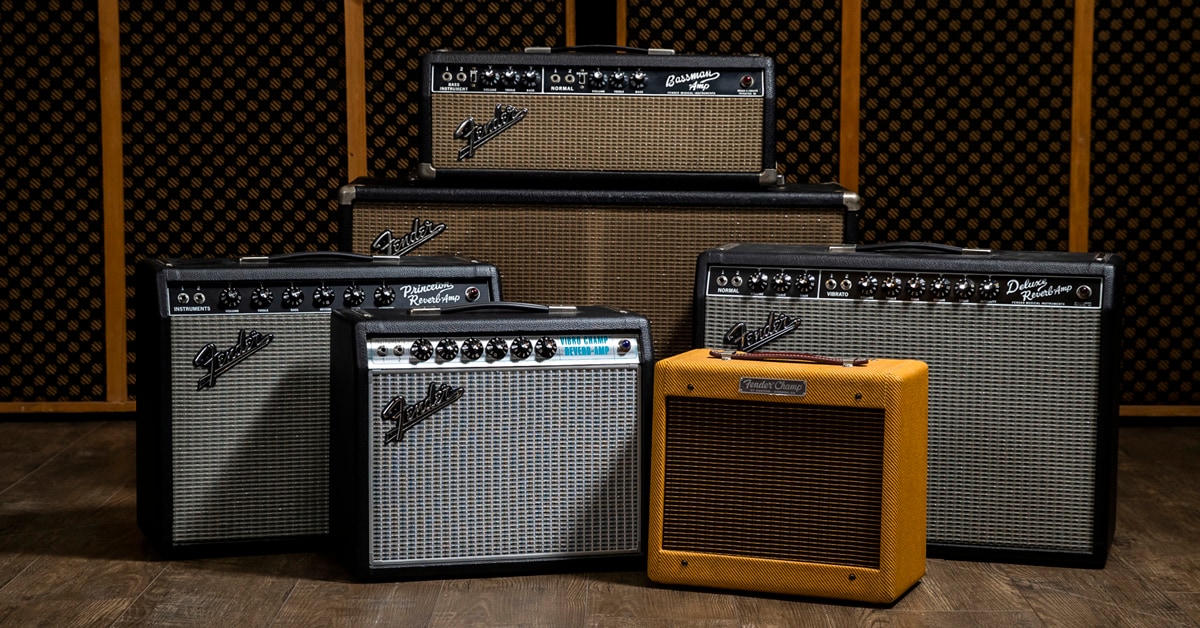There’s no denying that Leo Fender changed the course of music history with his electric and bass guitars, but his amps were just as revolutionary. The first Fender amps hit store shelves in 1946, and Fender has been at the forefront of amplifier design ever since. Today, they offer a wide range of amps, from all-tube reissues that capture classic tone like the '65 Princeton Reverb and the ’68 Vibro Champ Reverb models, to solid-state powerhouses like the Mustang GTX 100 and Champion 20 amplifiers. With so many options available, even just browsing can be a bit overwhelming. That’s where this guide comes in. We’ll help you navigate the exhaustive lineup of Fender guitar amps and pick the one that’s best for you and your instrument.
If you’re looking for that authentic Fender sound, it really comes down to what time period you have in mind. Many players love the less clean ’50s tweed era tone, yet the legendary black panel era (and, to an extent, its short-lived brown panel predecessor) took the ’60s by storm for a reason. That was where the Fender sound would get refined and honed to perfection as louder and more aggressive music required amps that could keep up. The silver panel era followed, bringing Fender into the modern day with their loudest, cleanest tone yet and electronic tweaks that players still love. The current offering of Fender amps contains tube amp reissues from each of these vintage periods as well as modern tube-amps, digital modeling amps, solid-state amps, acoustic amps and more, providing players from all walks of life with a guitar amplifier that fits exactly what they need.
Table of Contents
Comparing Fender Amplifier Families
The Tweed Era Lineup: The Foundation of Fender
Fender Brown Panel Amps: The Move from Crunch to Clean
Fender Black Panel Era Lineup: The Sound of Classic Rock
Fender Silver Panel Era Lineup: The Mod Squad
Bassbreaker Lineup: Fender Takes on British Tone
Hot Rod Lineup: Fender Heats Up
Fender Modeling and Solid-State Amps
Fender Acoustic Guitar Amps: Maximize Acoustic-Electric Tone
Fender Mini Amps: Pocket-Sized Projection
Vintage Fender Amps: Ain't Nothin' Like The Real Thing
Comparing Fender Amplifier Families
|
Amp Family |
Tonal Qualities |
Musical Applications |
|
Tweed |
Warm, dynamic, early breakup; rich harmonics |
Blues, rockabilly, vintage rock, Americana |
|
Brown Panel |
Thicker mids, more breakup than Tweed; slightly looser bass |
Surf, instrumental rock, roots, indie |
|
Black Panel |
Bright, glassy cleans with scooped mids; classic reverb and tremolo |
Classic rock, blues, funk, country |
|
Silver Panel |
More pronounced mids; vintage tone with modern tweaks |
Vintage-inspired indie, soul, classic pop |
|
Bassbreaker |
British-voiced; mid-forward gain; tighter bass; modern breakup |
Modern blues, alt-rock, hard rock |
|
Hot Rod |
High headroom cleans; bold midrange; versatile overdrive |
Blues, rock, country, jazz, gigging |
|
Tone Master |
Digital tube modeling; authentic dynamics; modern convenience |
All genres, studio/stage hybrid needs |
|
Modeling (GTX/LT) |
Multiple amp models; built-in effects; USB connectivity |
Practice, learning, genre exploration |
|
Solid-State (Champion) |
Clean digital tones; built-in effects; reliable operation |
Beginners, practice, small venues |
|
Acoustic |
Natural acoustic enhancement; vocal-ready inputs; portable |
Acoustic, folk, singer-songwriter, coffee shops |
|
Mini/Micro |
Desktop/headphone practice; battery power; compact portability |
Silent practice, travel, office jamming |
The Tweed Era Lineup: The Foundation of Fender
The tweed era pretty much started it all. They weren’t the first amps Fender ever produced, but they’re the ones that really got the ball rolling. Known for their durable, easily repairable covering and simple controls, these amps were made to survive life on the road and are still loved by musicians today. Fender has reissued these tweed amps to recreate the old-school overdrive, classic cleans and low-volume breakup Fender tweed amps are known for.
Comparing Fender Tweed Amplifiers
|
Model |
Wattage |
Speaker(s) |
Channels |
Onboard Effects |
Tonal Characteristics |
|
5W |
1x8" Weber Special Design Alnico |
1 |
None |
Sweet overdrive at low volumes; perfect recording amp tone |
|
|
12W |
1x12" Eminence Special Design Alnico |
2 (Mic/Instrument) |
None |
Bigger attitude than Champ; creamy cleans and hearty overdrive |
|
|
40W |
2x12" Eminence Special Design Alnico |
2 (Normal/Bright) |
None |
Clean powerhouse; pleasant tone at high volume |
|
|
45W |
4x10" Jensen P10R |
2 (Normal/Bright) |
None |
The ultimate guitar amp; sounds best cranked all the way up |
Fender ’57 Custom Champ
Why It's Cool: This little beast is loaded with rich, harmonically complex tones at neighbor-friendly volumes, making it a studio favorite.
Things to Consider:
- Simple, single-knob design invites you to shape your tone with your hands and guitar controls
- Low wattage makes it ideal for recording, rehearsal or practice
- Classic Tweed breakup without shaking the walls—a boon for players chasing authentic sag
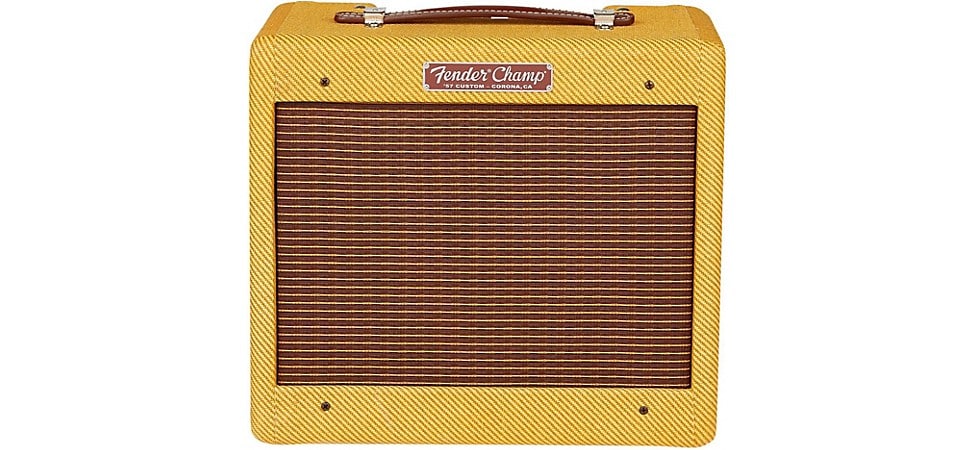
Shop Now: Fender '57 Custom Champ
The original ’57 Fender Champ was easily one of the most popular amps ever made. If that piques your interest, you may be set with this spot-on reissue. Supremely versatile, the original 5-watt Champ was initially marketed as a student model but became quickly regarded as an excellent recording amp. The hand-wired ’57 Custom Champ reissue contains a single 8" Weber Special Design alnico speaker, a 12AY7 preamp tube, a 6V6 power amp tube, a 5Y3GT rectifier tube and a design based on the original 5F1 circuit, producing amazing cleans and dirty crunch that’s great for blues and rock. Original tweed Fender Champs were used on Eric Clapton’s famous song “Layla” and the opening track from Joe Walsh’s The Smoker You Drink, The Player You Get album. However, the reissue has also gained some traction in the jazz world lately, thanks to jazz guitarist Julian Lage’s usage of a tweed Fender Champ on his 2016 album Arclight. The ’57 Champ doesn’t offer much in the controls department aside from a Master Volume and On/Off switch, but it makes up for that with plenty of charm and tone.
Fender ’57 Custom Deluxe
Why It's Cool: Touch sensitive and famously sweet when pushed, the Deluxe is a go-to for Tweed tone enthusiasts and studio hounds alike.
Things to Consider:
- Breaks up early, giving you rich drive tones at manageable volumes
- Pure signal path keeps your tone organic and makes this a superb pedal platform
- Matches well with vintage-style single coils, humbuckers or P-90s
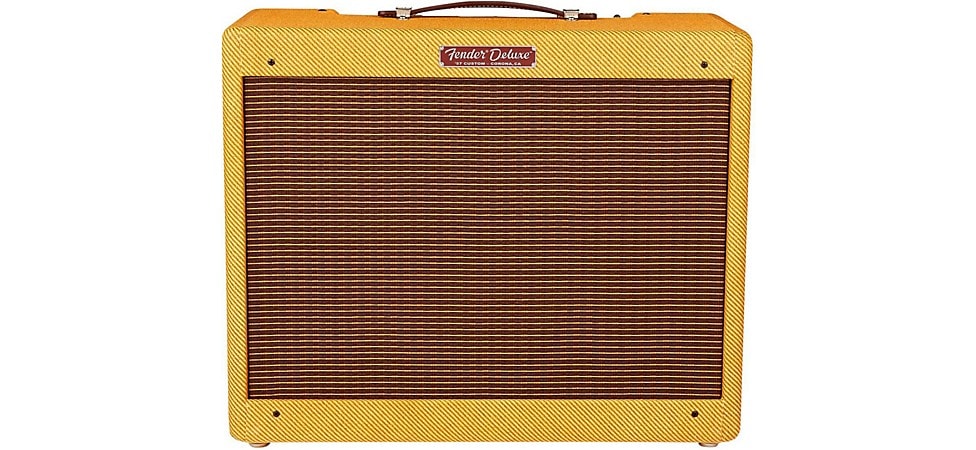
Shop Now: Fender '57 Custom Deluxe
Very similar to the ’57 Custom Champ in performance, the tweed era '57 Custom Deluxe reissue turns the power up to 12 watts with a 12" Eminence Special Design alnico speaker. With a design based on the original 5E3 circuit, this Custom Deluxe reissue features single 12AY7 and 12AX7 preamp tubes, two GT6V6 power amp tubes and a 5Y3 rectifier tube. Also hand-wired, the two-channel ’57 Deluxe reissue delivers the same sweeping cleans and hearty overdrive as the Custom Champ reissue but with a little more attitude. The original tweed Deluxe amps were produced in the ’50s but their tone is often associated with the ’70s. For quick reference, Neil Young has used an original tweed Deluxe since the late ’60s. The Custom Deluxe reissue is great for recording but also makes for a perfect club-sized performance amplifier. Individual volumes are included for the mic and instrument channels (which are identical), as well as a master tone for a little more sonic fine-tuning than the Custom Champ.
Fender ’57 Custom Twin
Why It's Cool: With huge clean headroom and a lush, warm voice, the Twin is a cathedral of classic Tweed tone.
Things to Consider:
- Big tone and bold projection make it suitable for larger stages or pedal-based rigs
- For players who need volume with nuance—touch dynamics shine through even at higher settings
- Combines vintage vibe and ample stage power
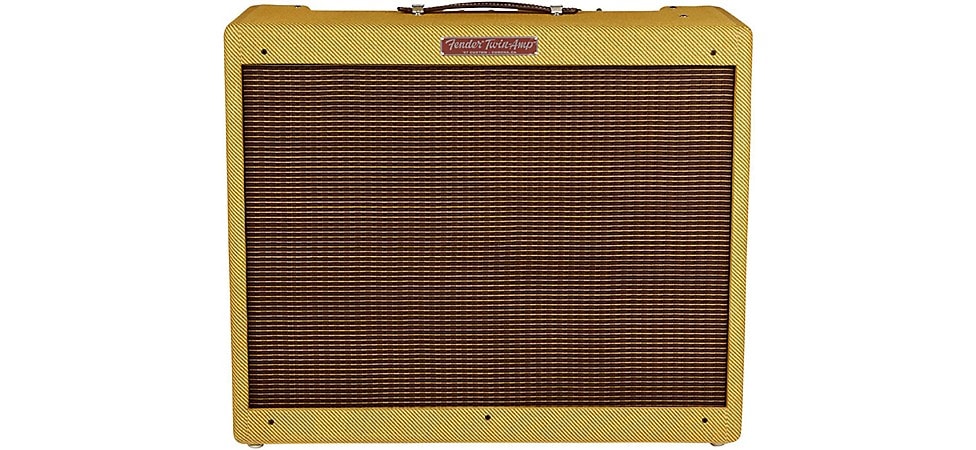
Shop Now: Fender '57 Custom Twin
If you love exploring those traditional rock sounds but need even bigger and cleaner performance power, the heavy-duty ’57 Custom Twin reissue packs in two 12" Eminence Special Design alnico speakers, a design based on the original 5E8A circuit, two 12AY7 preamp tubes and a hefty 40 watts from four 6L5 power tubes. The control set gets a bit more extensive here as well with Presence, Bass and Treble controls, plus individual volume knobs for both the Normal and Bright channels. Hand-wired and responsive, this throwback Fender amp comes through gig after gig with creamy, pleasant tone, especially at high volume. The original model was Leo Fender’s solution for professional players looking to fill the space of large ballrooms and roadhouses, so the ’57 Custom Twin is a noticeable jump in power from the Deluxe and Champ ’57 reissues. Versatile and punchy, the tweed era Custom Twin is a great choice if you like going loud and clean.
Fender ’59 Bassman
Why It's Cool: Experience the legendary tone that helped shape rock ‘n’ roll—tight lows, sparkling highs and an unmistakable mid growl.
Things to Consider:
- Originally built for bass, it provides exceptional clarity and punch for guitar
- 4x10" speaker array creates a bold, articulate soundstage—especially loved by Strat and Tele players
- Comes alive when pushed—great for expressive lead work and dynamic rhythm playing
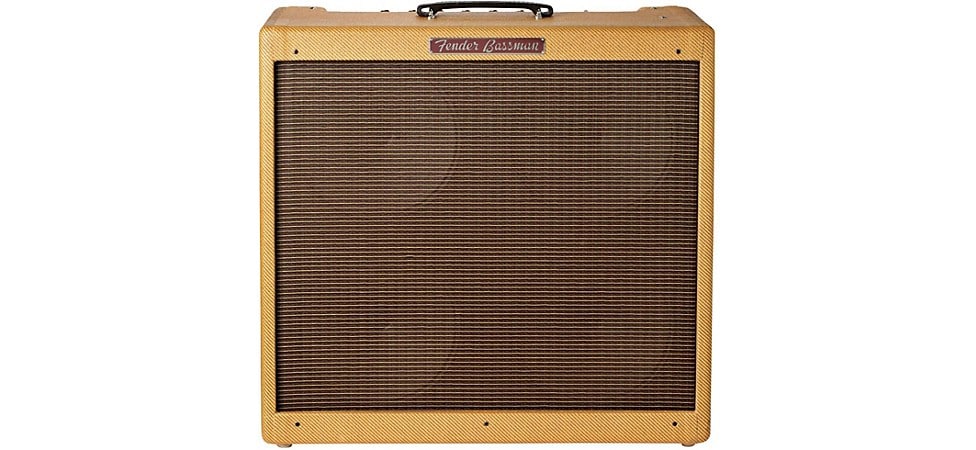
Shop Now: Fender Vintage Reissue '59 Bassman
Rounding out the classic tweed lineup is the Vintage Reissue ’59 Bassman amp. Originally released as a bass amp to complement the launch of the Precision Bass, the Fender Bassman is now considered to be the ultimate guitar amplifier. The Fender ’59 Bassman is the pro version of the tweed reissue line with a focus on big sound, reliable performance and streamlined controls. Rated for 45 watts, the Bassman includes four 10" Jensen P10R speakers that—to put it simply—bring the noise. This is facilitated by four 12AX7 and two 12AT7 preamp tubes along with four 6L6 power tubes. Both Normal and Clean channels feature two inputs but the ’59 Bassman also adds a Middle control, just like the original version. Great for gigging guitarists, the Fender Bassman works best cranked alllll the way up. It was reportedly the Beatles favorite amp (as seen in their famous rooftop performance), but you can also count Brian Setzer as a more contemporary advocate of the Bassman as heard on “Rock This Town” by the Stray Cats.
Fender Brown Panel Amps: The Move from Crunch to Clean
Following the tweed amps, Fender moved briefly into their brown panel phase, so called for their prominent brown face plates. These were mostly significant for adding two-channel circuitry and front-facing controls during a time when guitarists moved from sitting behind their amps to rocking out in front of them. Those increasingly efficient and versatile amplifiers would also start to incorporate onboard reverb and tremolo effects, which helped them gain popularity with jazz and country artists as well.
Comparing Fender Brown Panel Amplifiers
|
Model |
Wattage |
Speaker(s) |
Channels |
Onboard Effects |
Tonal Characteristics |
|
40W |
2x10" Jensen |
2 (Normal/Vibrato) |
Harmonic Tremolo |
Cult classic bridging tweed warmth and black panel clarity |
|
|
12W |
1x12" |
2 |
Vibrato |
Modern 12" speaker with authentic brown panel vibe |
|
|
40W (dual power sections) |
1x15" + 1x10" |
2 |
Stereo Harmonic Tremolo/Reverb |
Unique stereo configuration based on White's favorite vintage amps |
Fender American Vintage '62 Super Amp
Why It's Cool: This amp resurrects a cult classic, bringing lush harmonic tremolo, and the sag and bloom of vintage tube rectification back into the spotlight.
Things to Consider:
- Long prized by tone chasers for bridging Tweed warmth with black panel clarity
- 5AR4 tube rectifier provides natural sag and bloom that enhances musical dynamics
- Harmonic Tremolo provides complex modulation effect that influenced a generation of players seeking vintage vibe

Shop Now: Fender American Vintage '62 Super Amp Reissue
Before there was the Super Reverb, there was the brown-panel Fender Super. Like other amps from the short-lived brown-panel era, it bridged the gap between the rich warmth of the tweed circuits and the cleaner punch of the later black-panel designs. The original 1962 Super has long been a secret weapon for tone chasers, prized for its lush harmonic tremolo, the sag and bloom of a 5AR4 rectifier, and the smooth breakup of a well-pushed 6L6 output stage, as well as its cream on brown aesthetic. With 40 watts of power and a pair of 10" speakers, this Fender American Vintage ’62 Super Amp reissue brings a cult classic back into the spotlight.
Fender '62 Princeton Chris Stapleton Edition
Why It's Cool: Designed with Chris Stapleton, this handwired Princeton captures the soulful warmth and vintage mojo that powers his sound—on stage and in the studio.
Things to Consider:
- Vintage-style breakup and bubbly tube-bias tremolo make it a joy to play with touch and dynamics
- 12" speaker gives it more low-end depth than you’d expect from a compact design
- Ideal for recording, songwriting and intimate performances where nuance matters

Shop Now: Fender '62 Princeton Chris Stapleton Edition
The ’62 Princeton Chris Stapleton amp includes a more modern, performance-focused 12" speaker rather than the period-accurate 10". Historically, many amp manufacturers used vibrato and tremolo interchangeably. In strict musical terms, vibrato refers to slight variations in pitch, and tremolo refers to slight changes in volume. Fender’s first version of the effect, on the 1955 Tweed Tremolux was correctly named, but by 1963, they had changed it to vibrato. So that’s what we’ll be calling it on these amps.
Fender Jack White Pano Verb
Why It's Cool: Jack White’s signature amp captures his raw, overdriven aesthetic while adding a retro-futurist spin to the Brown Panel legacy.
Things to Consider:
- Dual, different-sized speakers (10" and 15") provide unique character
- Discrete power amps for each speaker provide a full stereo rig in a single cabinet
- Assignable reverb can be shaped for each speaker independently

Shop Now: Fender Jack White Pano Verb Amp
Based on several of his favorite amps, including a 1960 Vibrasonic and a 1964 Vibroverb, the Jack White Pano Verb amp definitely carries its brown panel DNA far forward. With a unique 15" plus 10" speaker configuration and Fender's early ’60s-era harmonic tremolo, modified to stereo for this amp, plus a reverb that can be shaped for tone and assigned to one or both of the speakers, there is a lot more going on here than just the distinctive looks and vintage vibe. These effects combine with the Pano Verb's 40W of power to produce an incredibly lush, full, three-dimensional sound that's equally effective in the recording studio and on stage. It's especially effective when miked in stereo and spread across your soundfield.
Fender Black Panel Era Lineup: The Sound of Classic Rock
The shift from brown panel to black panel designs in 1963–64 was not as big a change in circuit designs as the change from tweed to brown panel, but a more subtle update. Among other things, Fender increased capacitor values and transformer size to give the black panel amps more headroom, so the amps could be pushed harder before they began to distort, as amp distortion wasn't seen as desirable at the time. There were also some changes in the tone circuitry that gave a wider, more subtle range of operation and the instantly recognizable warm but "glassy" tone that became Fender's signature. These factors combined to create a line of amps that would prove to be superb pedal platforms, and are one of the principle reasons the "black panel" sound is still so in demand today—as Fender's ’65 Black Panel reissue line proves.
Comparing Fender Black Panel Amplifiers
|
Model |
Wattage |
Speaker(s) |
Channels |
Onboard Effects |
Tonal Characteristics |
|
12W |
1x10" Jensen P10R Alnico |
1 |
Tube Reverb/Tremolo |
Handwired AA764 circuit with premium components and boutique construction |
|
|
12W |
1x10" Jensen C10R |
1 |
Long-Spring Reverb/Tube Tremolo |
Classic PCB construction for traditional black panel sound |
|
|
20W |
1x12" Jensen C-12Q |
2 (Bright/Normal) |
Tube Reverb/Tremolo (both channels) |
Handwired AB763 circuit with premium Jensen speaker |
|
|
22W |
1x12" Jensen C12K |
2 (Normal/Vibrato) |
Tube Reverb/Tremolo (Vibrato channel only) |
The most recorded amplifier in history |
|
|
45W |
4x10" Jensen P10R |
2 (Normal/Vibrato) |
Tube Reverb/Tremolo |
Scooped mids; shimmering highs rounded lows |
|
|
85W |
2x12" Jensen C12K |
2 (Normal/Vibrato) |
Tube Reverb/Tremolo |
The king of black panel amps with earthshaking power |
Fender '64 Custom Princeton Reverb
Why It's Cool: Handwired AA764 circuit, premium parts and solid pine chassis give this version a purist’s appeal—offering vintage layout and tone with top-tier build quality.
Things to Consider:
- All the sound of the standard model in a boutique-grade build
- Handwired construction with premium components
- Built for players who want vintage tone with lasting value
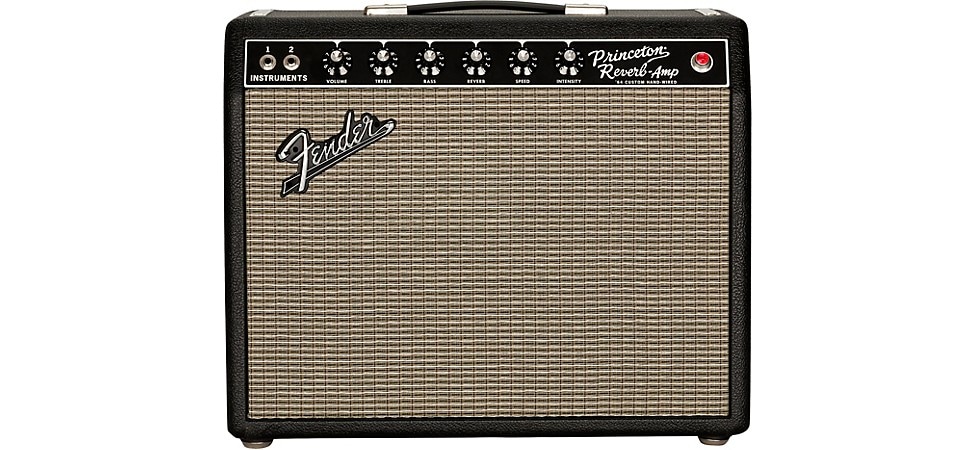
Shop Now: Fender '64 Custom Princeon Reverb
If you like the idea of the tweed era Champ or Deluxe but need that sweet tremolo, check out the more upscale Custom Princeton Reverb all-tube reissues. The original Fender Princeton Reverb amps have been a favorite among studio musicians for decades, in part because they’re the smallest Fender amps available with tremolo and reverb included. Just like those original amps, the '64 Custom Princeton Reverb reissue is rated for 12 watts and contains one 10" Jensen P10R speaker. The low-wattage Fender Princeton might not seem powerful enough for a live performance, but many guitarists—including Mike Campbell of Tom Petty & the Heartbreakers—would disagree.
For the purists out there, the ’64 Custom Princeton Reverb amp features a hand-wired AA764 circuit with tube-driven spring reverb and tremolo. It contains one 10" Jensen alnico P10R speaker, three 12AX7 preamp tubes and one 12AT7, a 5AR4/GZ34 rectifier tube and a matched pair of 6V6 power tubes.
Fender '65 Princeton Reverb Reissue
Why It's Cool: A studio classic with sparkling cleans, smooth breakup and lush built-in effects—it’s everything you want from a small Fender combo.
Things to Consider:
- Compact, light and perfect for recording or miked live use
- Touch-sensitive response rewards dynamic players
- Hits that "edge-of-breakup" sweet spot at practical volumes
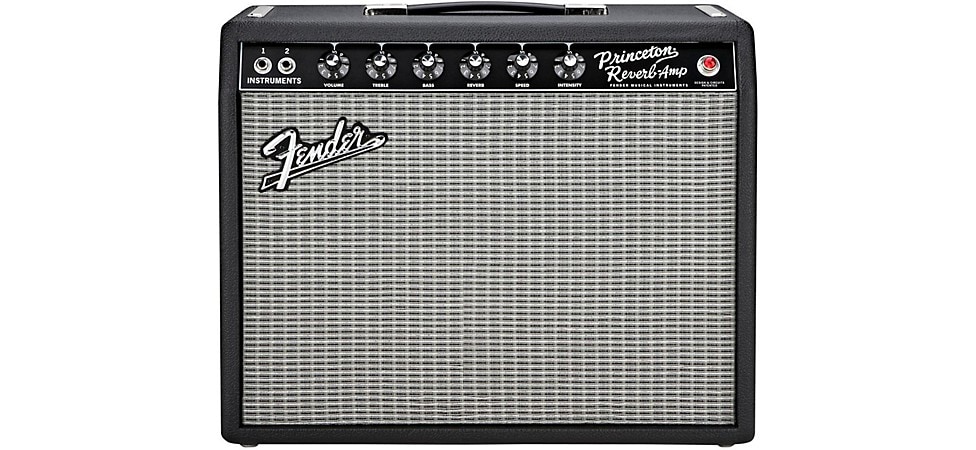
Shop Now: Fender '65 Princeon Reverb
If you're not into paying the premium for the hand-wired labor and parts upgrades, you can get the ’65 Princeton Reverb reissue. This version features a printed circuit board, a 10" Jensen C10R speaker, long-spring reverb and tube tremolo. Both iconic amplifiers deliver a clean, clear tone with a classic overdrive when pushed.
Fender '64 Custom Deluxe Reverb
Why It's Cool: Handwired AB763 architecture with Vintage Blue capacitors and premium parts—while tonally faithful to the standard reissue, it enhances build quality and service longevity.
Things to Consider:
- Handwired AB763 circuit rivals any boutique amplifier
- Unlike the '65 version, tremolo works on both Bright and Normal channels
- Premium Jensen C-12Q speaker for enhanced clarity and projection
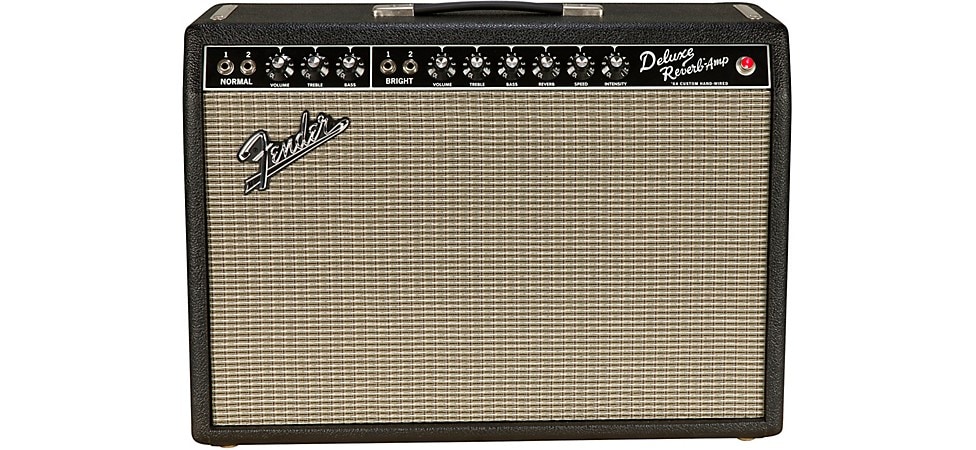
Shop Now: Fender '64 Custom Deluxe Reverb
The Fender Deluxe amps of the black panel era kicked things up a notch with the addition of the classic black aesthetic, along with onboard reverb and tremolo effects. The style and tone of those classic amps are captured in the Deluxe Reverb reissues, with a 12" Jensen speaker that delivers sparkly cleans and earlier breakup for a slight British flavor. Unlike the ’57 Custom Deluxe reissue, the ’60s Deluxe reissues feature Bright and Normal channel options rather than simply two separate but identical channels.
Like the Princeton black panel reissues, you have the option of the boutique ’64 and the more mainstream ’65 Deluxe, but the differences don’t end there. The ’64 Custom Deluxe Reverb reissue delivers 20 watts of power and contains a 12" Jensen C-12Q speaker, a hand-wired AB763 circuit, four 12AX7 and two 12AT7 preamp tubes, a 5AR4/GZ34 rectifier tube and a matched pair of 6V6 output tubes. The ’64 Deluxe Reverb also provides tremolo on both the Clean and the Normal channels.
Fender '65 Deluxe Reverb
Why It's Cool: An iconic 22-watt amp known for its glassy black panel cleans, authoritative tone, and onboard spring reverb and tremolo—this amp’s signature sound has shaped countless records.
Things to Consider:
- Dual inputs for a choice of warm, full cleans, or added sparkle and reverb/tremolo
- Smooth breakup at gig volumes serves both pedal artists and vintage purists
- Renowned for touch sensitivity at all volume levels
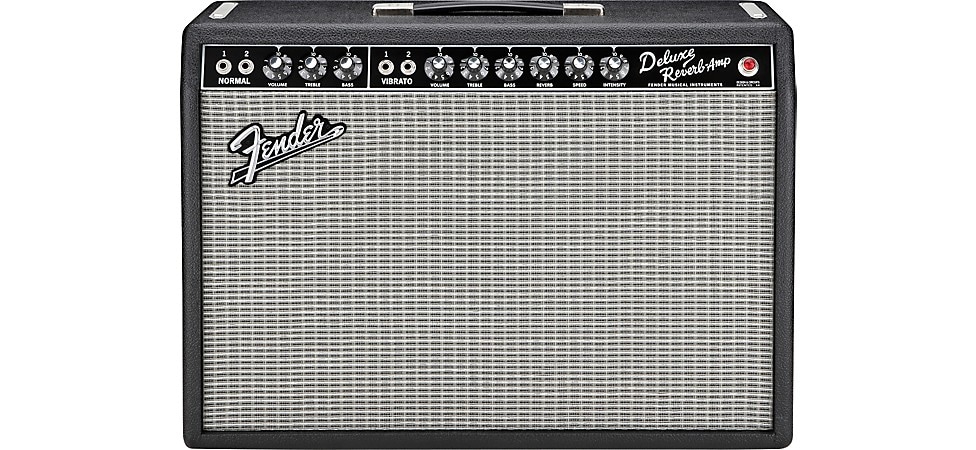
Shop Now: Fender '65 Deluxe Reverb
The ’65 Deluxe Reverb reissue gives you 22 watts of power with tremolo only on Channel 1. Inside the ’65 Deluxe Reverb is a 12” Jensen C-2K speaker and tube-driven Fender reverb and tremolo.
By the way, if you’re looking for a Deluxe Reverb type amp that offers even more versatility, check out the Super-Sonic 22 Combo. Based on the original Deluxe Reverb power section, the Super-Sonic has the organic feel and mid-level power of a Deluxe, but with expressive, modern high gain. It also features an extra voicing on the Clean channel for a fatter tweed sound when you feel like kicking it old school.
Fender ’65 Super Reverb
Why It's Cool: A 45-watt monster with four 10" speakers and lush Black Panel reverb/tremolo, the Super packs serious sonic presence while staying true to vintage Fender elegance.
Things to Consider:
- Four 10" speakers provide massive projection with crystal-clear cleans
- Rugged build handles stages, studios and pedalboard setups
- Classic tremolo and reverb serve as tone enhancers rather than effects—musical and natural
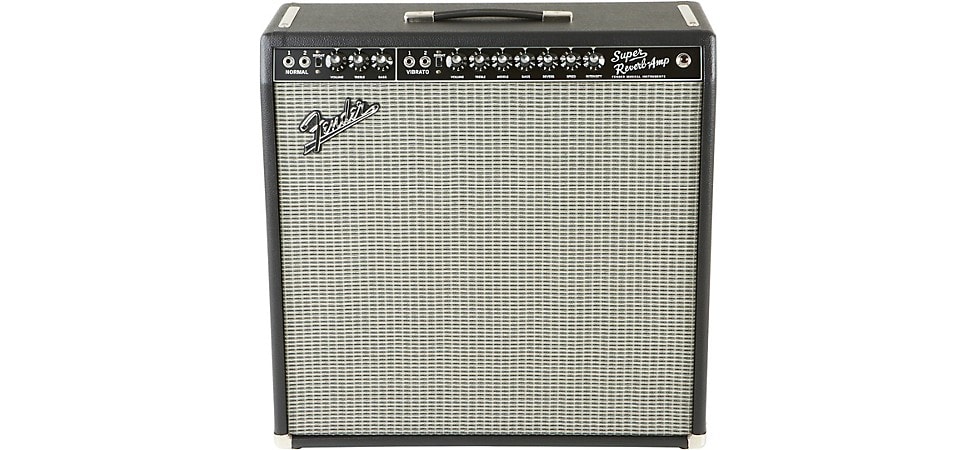
Shop Now: Fender '65 Super Reverb
Fender Super Reverb amps have been long-time favorites of live blues and rock guitarists because of their gutsy growl that can easily compete with a bass on stage. With 45 watts of tube power and four 10" Jensen P10R speakers, the ’65 Super Reverb amp allows for further tremolo manipulation with Speed and Intensity controls. Known for scooped mids, shimmering highs and rounded lows delivered by four 12AX7 and two 12AT7 preamp tubes, two 6L6 power tubes and a 5AR4 rectifier tube, the Fender ’65 Super Reverb is great for filling large stages with authentic Fender tone. Look to Alex Lifeson on the Rush album 2112 for a famous use of the ’65 Super Reverb amp.
Fender ’65 Twin Reverb
Why It's Cool: This undisputed king of clean tone is used by legends in every genre.
Things to Consider:
- 85 watts of crystal-clear cleans at any volume level
- Tilt-back legs and roadworthy construction built for touring
- The amp that defined the sound of rock, blues and country for generations
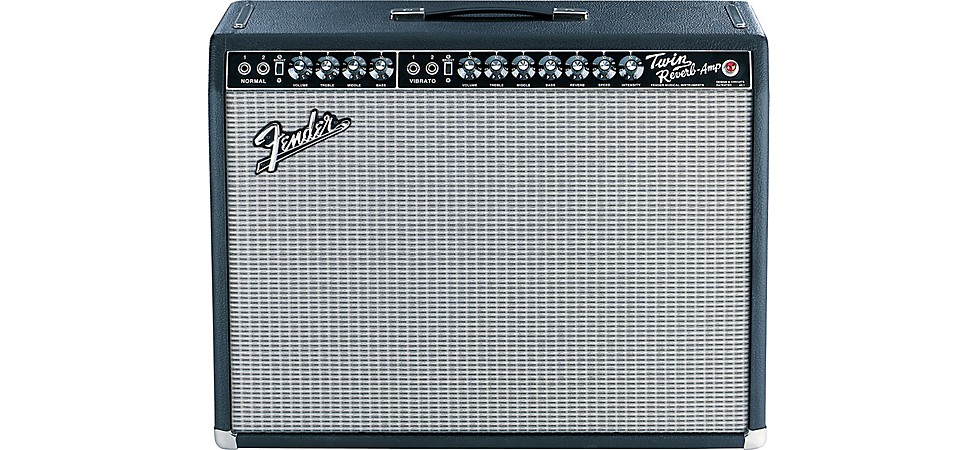
Shop Now: Fender '65 Twin Reverb
Many of these black panel reissues can easily pull double duty when it comes to recording in the studio and live performance. But for a powerhouse Fender amp that is truly designed for anything thrown its way, the ’65 Twin Reverb reissue is deservedly the king of the black panel amps. While both the ’57 Custom Twin and the ’65 Super Reverb reissues offer 45 watts, the ’65 Twin Reverb delivers an earthshaking 85 watts for nearly double the power. This souped-up Twin Reverb reissue contains two 12" Jensen C12K speakers, four 12AX7 and two 12AT7 preamp tubes and four 6L6 power tubes that empower both the Normal and Vibrato channels to take your playing to the next level. Also great for live settings, the ’65 Twin Reverb includes tilt-back legs to conveniently adjust for volume and sound direction. A true staple of modern music, the Twin Reverb has been used through the decades by luminaries such as Peter Green from Fleetwood Mac, Steve Jones of the Sex Pistols, and Jack White.
Fender Silver Panel Era Lineup: The Mod Squad
In the mid-60s, the Fender Company was sold to CBS, which soon ushered in the silver panel period of Fender amp design. There were few changes to these “new” amps internally, but at the time of their initial production, they suffered mainly from just not being the wildly popular black panel amps. What the ’68 Custom lineup of Fender reissues does is combines aspects of the traditional Fender sound with a few modern enhancements based on popular mods performed on original silver panel amps. You may lean more towards a silver panel reissue over black panel if you prefer earlier breakup or want to incorporate more pedals into your setup.
Comparing Fender Silver Panel Amplifiers
|
Model |
Wattage |
Speaker(s) |
Channels |
Onboard Effects |
Tonal Characteristics |
|
5W |
1x10" Celestion Ten 30 |
1 |
Hall Reverb/Tube Tremolo |
Enhanced low end with sparkly Fender tone |
|
|
12W |
1x10" Celestion Ten 30 |
1 |
Reverb/Tremolo |
Bassman tone stack for more mids and earlier gain |
|
|
22W |
1x12" Celestion G12V-70 |
2 (Custom/Vintage) |
Reverb/Tremolo (both channels) |
Dual personality with vintage and custom voices |
|
|
40W |
1x12" Celestion Neo Creamback |
1 |
Tube Reverb/Grid-Bias Tremolo |
Ultimate pedal platform with reduced negative feedback |
|
|
85W |
2x12" Celestion G12V-70 |
2 (Custom/Vintage) |
Tube Reverb/Tremolo |
Monster power with custom modifications |
Fender ’68 Custom Vibro Champ Reverb
Why It's Cool: This updated Champ keeps the vintage vibe but adds reverb and a 10" speaker for wider, fuller tone—perfect for home, studio and practice.
Things to Consider:
- Delivers early breakup and lush effects at low volume—great for tight spaces
- 10" speaker adds surprising depth to its compact frame
- A vintage-inspired favorite for players who want old-school feel with modern features
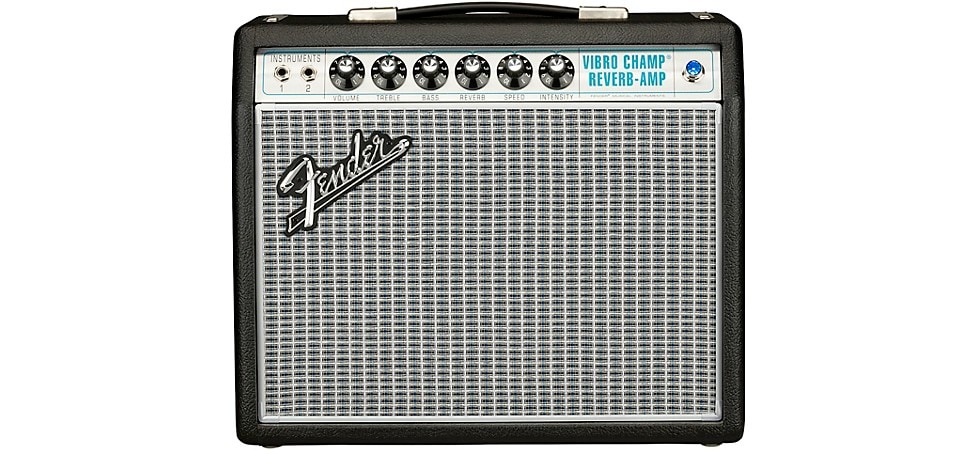
Shop Now: Fender '68 Custom Vibro Champ Reverb
The original tweed era Champ amplifier didn’t really get much in the way of updates until the mid-60s. The ’68 Custom Vibro Champ Reverb reissue captures those belated design enhancements with classic silver styling and stunning hall Reverb and tube-driven tremolo effects. These allow players to enhance the already sparkly Fender tone provided by two 12AX7 preamp tubes and one 6V6 power tube. If you’re going for a rousing Duane Eddy rock instrumental or a bluesy Jimmie Vaughan playing style, this little 5-watt reissue won’t let you down. A single 10" Celestion Ten 30 provides increased low end, making this peppy Fender amp ideal for rehearsal and recording. Unlike the ’57 Custom Champ reissue, you get a fuller slate of controls here with Treble and Bass as well as Volume, plus controls for Reverb, Speed and Intensity. The Fender ’68 Vibro Champ Reverb is a step up in functionality from the ’57 Custom Champ model, but with a slightly lower price tag.
Fender ’68 Custom Princeton Reverb
Why It's Cool: The ’68 Custom Princeton blends classic tone with a tweaked voicing that breaks up sooner and pairs beautifully with pedals.
Things to Consider:
- Chimey cleans with a little more grit than the Black Panel version
- Compact enough to carry, loud enough to gig when miked
- Onboard trem and reverb make it a self-contained tone machine
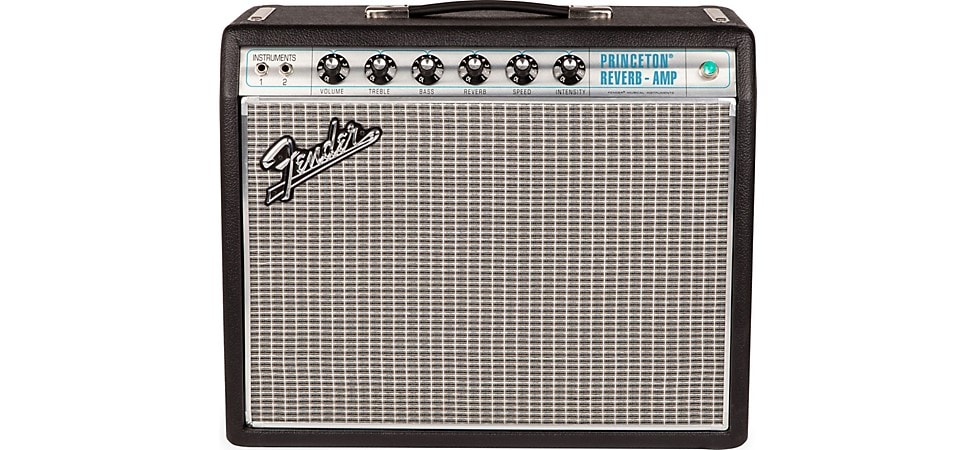
Shop Now: Fender '68 Custom Princeton Reverb
The ’68 Custom Princeton Reverb reissue is a small 12-watter that nails the silver panel aesthetic. Unlike like the ’64 and ’65 Princeton reissues, the one-channel ’68 Custom includes a 10" Celestion Ten 30 with a Bassman tone stack for more mids, deeper lows and earlier gain. The gorgeous tremolo is perhaps even more versatile than on the original models due to internal tweaks and improvements, but it still retains the full Fender flair with hand-wired tube sockets housing three 12AX7 and one 12AT7 preamp tubes, two 6V6 power tubes and a 5AR4 rectifier tube. This is an excellent all-tube amp for practice and recording sessions, as well as for gigs with a small band. Like all amps in the ’68 Custom line, the Princeton Reverb features reduced negative feedback for enhanced touch sensitivity. This feature may sound a bit intimidating to a student guitarist, but hearing every nuance of your playing is a great way to learn even faster. Regardless of your skill level, this silver panel reissue makes it easy to get surfy Dick Dale grooves, dirty hard rock crunch and outlaw country cleans, all from one little unit.
Fender ’68 Custom Deluxe Reverb
Why It's Cool: Get two personalities in one amp—vintage ’68 tone, plus custom modifications
Things to Consider:
- Dual personality—Vintage channel for classic Black Panel, Custom channel for earlier breakup
- Unlike '65 version, reverb and tremolo work on both channels
- Bright cap removal creates cleaner signal path for pedalboards
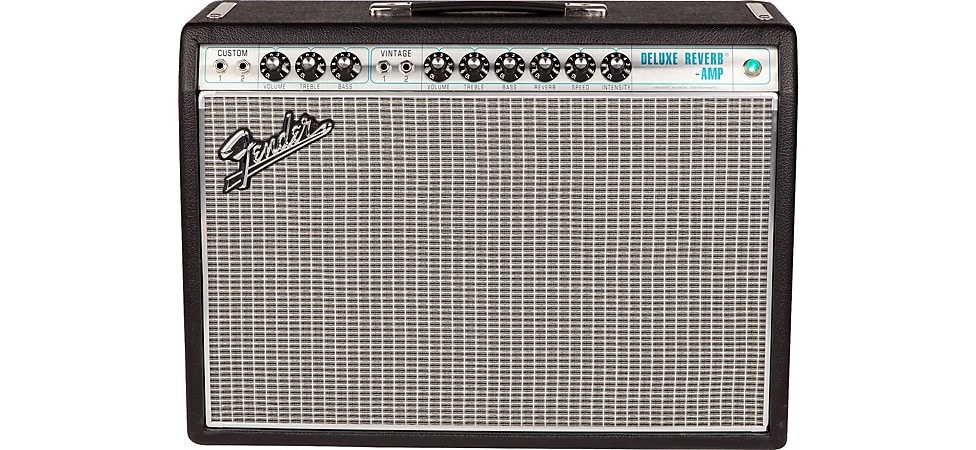
Shop Now: Fender '68 Custom Deluxe Reverb
The internals of the ’68 Custom Deluxe Reverb reissue remain largely the same as the ’65, with one 12" Celestion G12V-70 speaker, four 12AX7 and two 12AT7 preamp tubes, two 6V6 power tubes, a 5AR4 rectifier tube and 22 watts of power. The biggest change (aside from the silver styling) is the option to use Reverb and Tremolo on both the Custom and Vintage channels, rather than just one. The Vintage channel is based on the ’65 Deluxe Reverb reissue which gives you that unmistakable black panel tone, but the Custom channel includes a Bassman tone stack that delivers more low-midrange and earlier breakup. The bright cap found on the ’65 reissues has also been removed, making it much easier to control your own signal chain and get the most from your pedalboard. Small, light and moderately powered, the ’68 Deluxe Reverb is a practical selection for classic rock enthusiasts who love using effects.
Fender ’68 Custom Pro Reverb
Why It's Cool: This may well be the ultimate pedal-friendly amplifier for serious guitarists.
Things to Consider:
- Reduced negative feedback and effects loop make it perfect for stompboxes
- 40 watts in a surprisingly manageable package
- Mid control and bright switch provide precise tone shaping
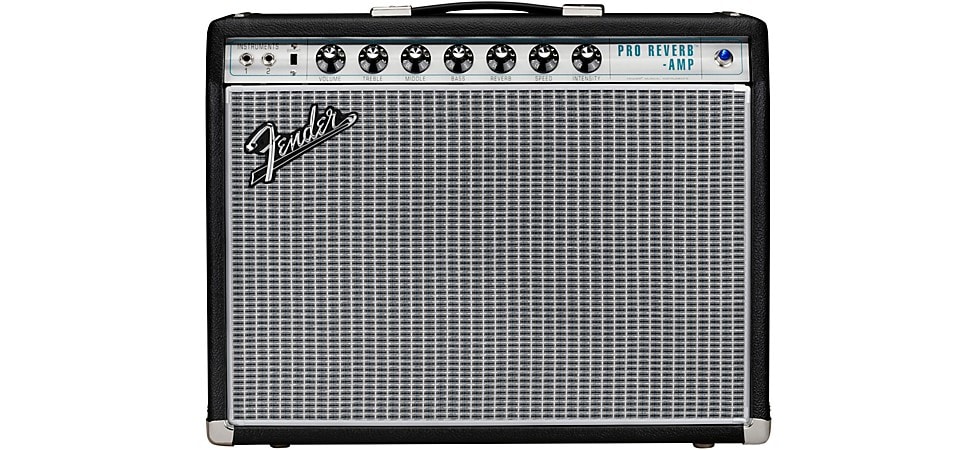
Shop Now: Fender '68 Custom Pro Reverb
With a lightweight cabinet, respectable 40-watt output and one 12" Celestion Neo Creamback speaker, the ’68 Custom Pro Reverb reissue is widely considered to be the ultimate pedal-friendly amplifier. It’s a serious amp for the serious guitarist and a reasonable size for any gig. Reduced negative feedback allows for more touch sensitivity, which is great when you’re nailing those solos. This single-channel ’68 Custom Pro amp includes tube-driven Reverb and grid-bias Tremolo effects, a Middle control and a bright switch for a bit more sonic sculpting ability compared to the ’68 Deluxe Reverb reissue. This practical Pro Reverb amp houses three 12AX7 and two 12AT7 preamp tubes and two 6L6 power tubes.
Fender ’68 Custom Twin Reverb
Why It's Cool: With bold headroom, tweaked midrange and built-in effects, this Twin balances Silver Panel sparkle with player-friendly punch.
Things to Consider:
- Perfect for pedal lovers and players who need big, clean volume
- Dual channels (Normal and Custom) offer tonal variety without overcomplication
- Captures the Twin’s iconic stage sound in a slightly more forgiving voicing
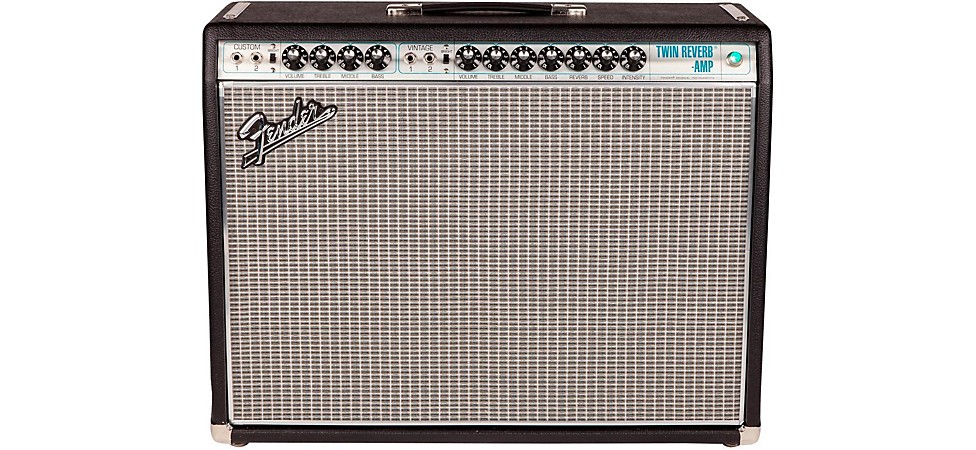
Shop Now: Fender '68 Custom Twin Reverb
While the ’65 Twin Reverb reissue is focused solely on truly vintage-correct tone, the ’68 Custom Twin Reverb reissue offers a decidedly custom variation with the same gargantuan 85 watts of power. The silver housing and period-specific “drip edge” detail capture the look of the silver panel era, but internal modifications give this two-channel vintage throwback even more tonal versatility. You still get full silver panel tone with the Vintage channel, but if you’re in the mood for something a little tastier, the Custom channel includes the Bassman tone stack for deep lows and early breakup. Both channels include tube-driven spring Reverb and Tremolo effects, a bright switch and clean power from four 12AX7 and two 12AT7 preamp tubes, four 6L6 power tubes and a solid-state rectifier feeding two 12” Celestion G12V-70 speakers. Very big, very heavy and very loud, the Custom Twin Reverb is a monster amp that provides dynamic tone with plenty of room for your favorite pedals.
Bassbreaker Lineup: Fender Takes on British Tone
After the tweed era of Fender amps, Leo Fender continued his mission to develop the cleanest guitar tones possible, leaving behind earlier circuit designs. The Bassbreaker lineup of amps imagines a world where Fender took a different route on circuit evolution, based more on dirty distortion and the EL34 or EL84-based power sections favored by British amp companies like Marshall or VOX. If you’ve ever wanted a classic Fender amp with a touch of Brit-inspired dirt, a Fender Bassbreaker amplifier is the fix you’re looking for. There are four amps in this line, each featuring its own distinct circuit.
Comparing Fender Bassbreaker Amplifiers
|
Model |
Wattage |
Speaker(s) |
Channels |
Onboard Effects |
Tonal Characteristics |
|
7W |
1x10" Celestion Ten 30 |
1 |
Switchable Treble Boost |
British-style crunch with EL84 power |
|
|
15W |
1x12" Celestion G12V-70 |
1 |
Built-in Reverb |
Studio-focused with XLR output and Power Amp Mute |
|
|
30W |
1x12" Celestion V-Type |
2 (Clean/Dirty) |
Effects Loop |
Gain boost footswitch and effects loop |
Fender Bassbreaker 007
Why It's Cool: This compact powerhouse blends classic EL84 crunch with Fender finesse, making it a killer grab-and-go amp for rich, saturated tone.
Things to Consider:
- Simple controls and 7 watts of tube power make it a great choice for recording or home use
- British-style voicing delivers tight, focused overdrive with minimal fuss
- Built-in treble boost adds edge and presence when you need to cut through
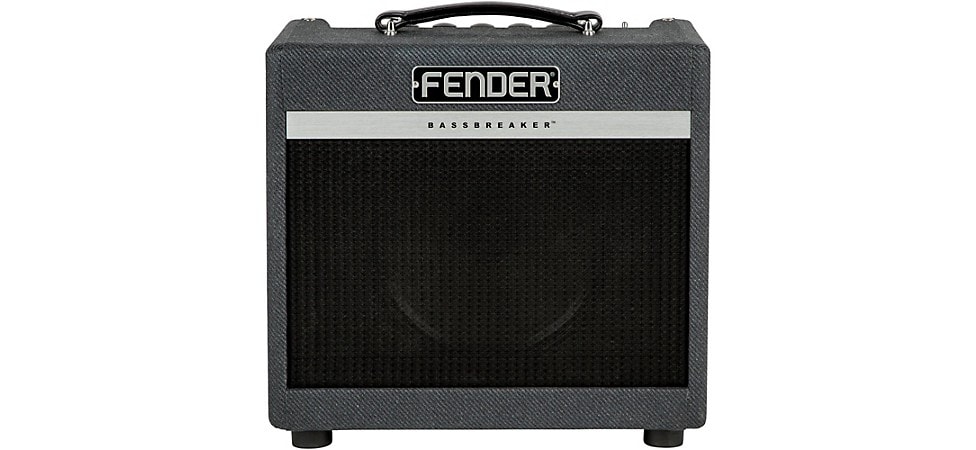
Shop Now: Fender Bassbreaker 007
The one-channel, 7-watt Fender Bassbreaker 007 definitely prefers things shaken, especially when it comes to chunky distortion. It’s still capable of rich cleans, but you also get full-on transatlantic overdrive and British-style crunch via one EL-84 tube, two 12AX7 tubes and one 10" Celestion Ten 30 speaker. The Bassbreaker 007 amp also includes a switchable vintage-style Treble boost as well as a speaker output for plugging in larger speaker configurations. This low-wattage amp is safe enough for home use—as far as the neighbors are concerned—but it can also easily handle rehearsal and recording too.
Fender Bassbreaker 15
Why It's Cool: The 15 packs serious tone flexibility with selectable gain structures and reverb, giving players the ability to shift from bluesy edge to modern grind.
Things to Consider:
- Versatile enough to cover clean to crunch and small-stage needs
- XLR line out and power scaling make it easy to gig, record or practice
- Mid-forward tone sits great in a mix and pairs well with humbuckers or single coils
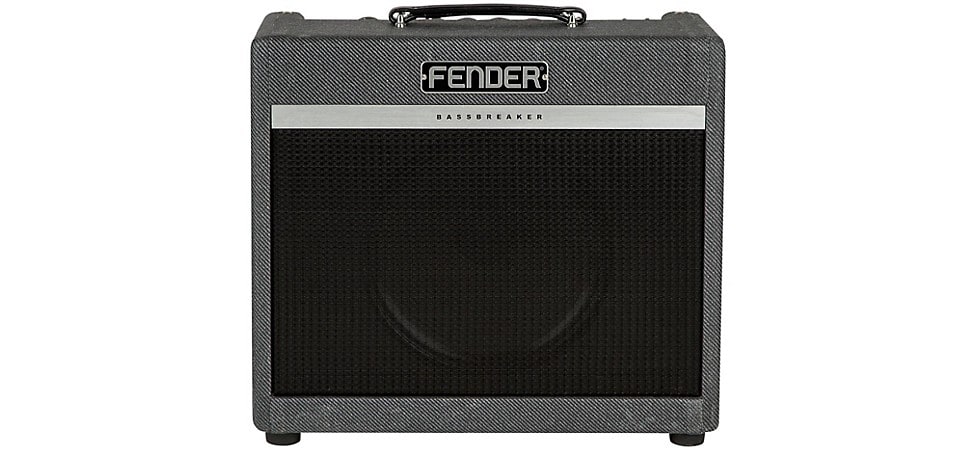
Shop Now: Fender Bassbreaker 15
For a Fender Bassbreaker amp geared more specifically toward studio recording, check out the Bassbreaker 15 combo. With features like an XLR line output for silent recording at home and a Power Amp Mute to silence the amp between takes, this popular tube amp adds a lot of convenience to recording sessions. Packing 15 watts, this flexible one-channel Fender Bassbreaker delivers breakup in three different gain structures for a variety of raw, crunchy goodness. Three 12AX7 preamp tubes, two EL84 power tubes, a solid-state rectifier and a single 12" Celestion speaker provide plenty of power for everything from bluesy cleans to LA metal. This is also the only Bassbreaker amp with built-in reverb. A head version is also available.
Fender Bassbreaker 30R
Why It's Cool: With two footswitchable channels and onboard reverb, the 30R is built for players who want dynamic performance without sacrificing tone.
Things to Consider:
- Dual channels give you rhythm and lead voices without pedalboard gymnastics
- Modern EQ and voicing mean it excels at indie, alt-rock and crunchy blues
- A sweet spot for guitarists who need flexible gain without digital modeling
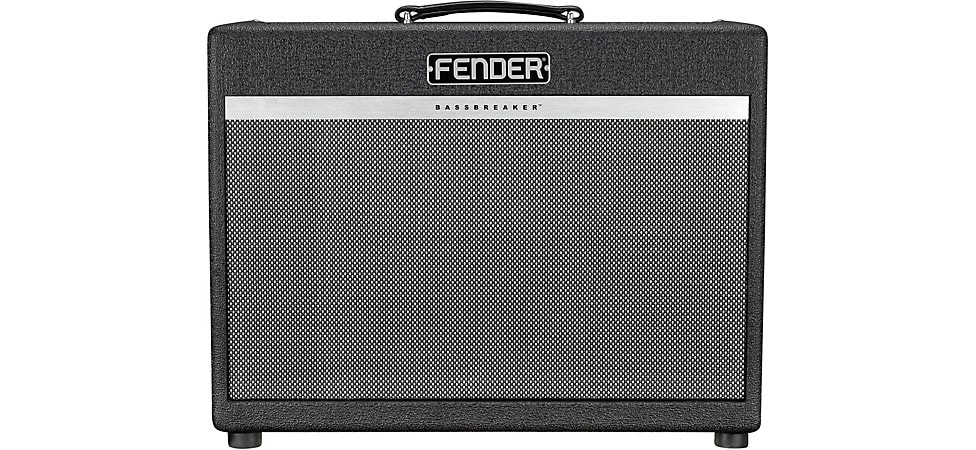
Shop Now: Fender Bassbreaker 30R
The Fender Bassbreaker 30R amp is the evolution of the Bassbreaker 15 with double the wattage and player-focused improvements based on customer feedback. You still get the supercharged high-gain distortion the Bassbreaker 15 is known for, but with twice the output power and additional modifications. While the 15 boasted a three-way switch, the Bassbreaker 30R amplifier includes a gain boost footswitch that can be applied to either the Clean or Dirty channels. Along with the XLR line output seen on the 15, the Fender 30R also adds an effects loop, making it a highly practical option for anyone who likes using pedals at high gain. A single 12" Celestion V-Type speaker is powered by four EL84 power tubes and three 12AX7 preamp tubes.
Hot Rod Lineup: Fender Heats Up
Originally released in 1996, the Fender Hot Rod lineup of amplifiers is now on its 4th generation. Designed with the contemporary gigging guitarist in mind, Hot Rod amps offer legendary Fender sound along with tonal upgrades, road-worthy durability and a little extra overdrive when needed. Geared more for modern-day convenience than period-perfect accuracy, the Fender Hot Rod series is played by more current artists than any other amp line.
Comparing Fender Hot Rod Amplifiers
|
Model |
Wattage |
Speaker(s) |
Channels |
Onboard Effects |
Tonal Characteristics |
|
15W |
1x10" Jensen P10R |
1 |
None |
Simplest controls; warmest tone in Hot Rod line |
|
|
15W |
1x12" Celestion A-Type |
1 |
Modified Spring Reverb |
Modified preamp for enhanced clarity |
|
|
40W |
1x12" Celestion A-Type |
2 |
Upgraded Spring Reverb |
More power and flexibility than classic Deluxe |
|
|
60W |
2x12" Celestion A-Type |
2 |
Spring Reverb |
Biggest and baddest in Hot Rod lineup |
Fender Pro Junior IV
Why It's Cool: It's the simplest tube amp in Fender's lineup—just Volume and Tone, but what tone!
Things to Consider:
- Minimalist design with just two knobs that deliver maximum tonal range
- Classic tweed covering with modern Hot Rod circuitry
- EL84 power tubes provide natural compression and sweet breakup
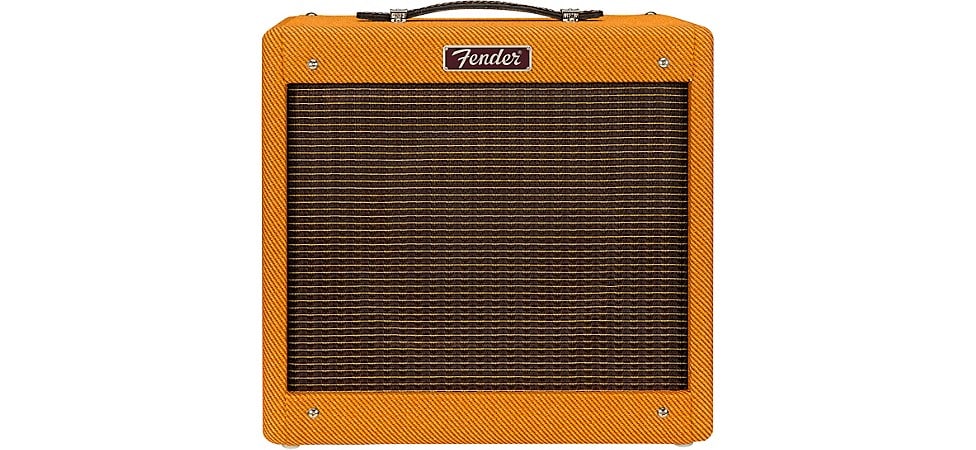
Shop Now: Fender Pro Junior IV
If you’re looking for a compact, contemporary amplifier, but really dig that throwback tweed look, check out the Pro Junior IV. The simplest and most streamlined of Fender’s tube amps, this 15-watter contains controls for Volume and Tone only. Don’t let that fool you though. The Fender Pro Junior is a workhorse amp with a nice range of warm tone delivered by two 12AX7 preamp tubes and two EL84 power tubes for both rich, traditional cleans and dirty crunch. One 10” Jensen P10R speaker produces plenty of volume for the home or studio and just enough for small gigs as well. Along with classic Fender sound, the Pro Junior IV offers both the vintage aesthetic of tweed and the modern-day circuitry of the Hot Rod series.
Fender Blues Junior IV
Why It's Cool: The tried-and-true classic gets Mark IV improvements for enhanced clarity and smoothness.
Things to Consider:
- Enhanced preamp circuitry allows more push without losing clarity
- Redesigned spring reverb sounds more musical and smooth
- Celestion A-Type speaker handles variety of styles with rock 'n' roll flair
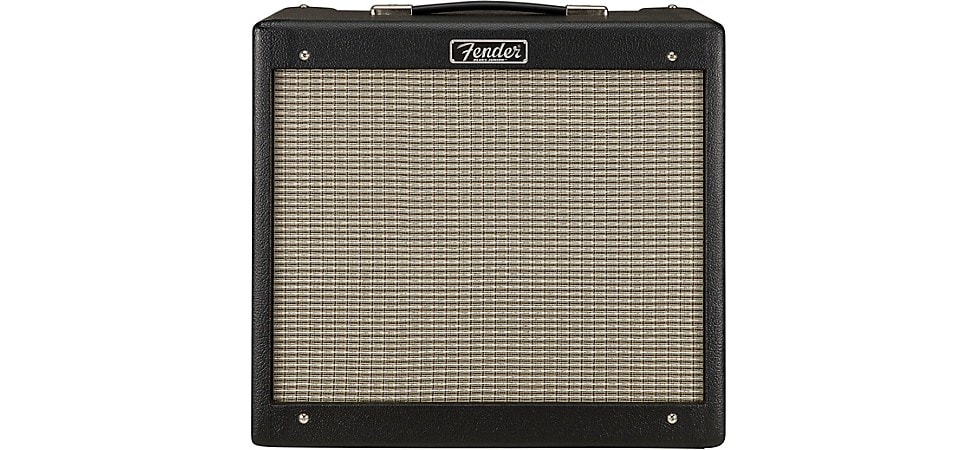
Shop Now: Fender Blues Junior IV
The Blues Junior IV offers improvements on what was already considered a tried-and-true classic. Mark IV of this popular small-tube combo includes modified preamp circuitry that allows you to push the amp a little further without losing any clarity. The spring reverb has also been modified for a more musical sound and improved smoothness. Inside, you’ll find one 12" Celestion A-Type speaker that can handle a variety of playing styles but roars with a rock ’n’ roll flavor thanks to three 12AX7 preamp tubes and two EL84 power tubes. With 15 watts of power, this single-channel amp is loud enough to gig with, yet still delivers great tone at low volumes for recording or solo practice sessions.
Fender Hot Rod Deluxe IV
Why It's Cool: The default backline amp at venues worldwide, the HRD adds power to the classic Deluxe concept.
Things to Consider:
- 40 watts of tube power makes this the go-to amp for working musicians
- Massive reliability has made it a standard on tour or as backline
- Packed with enhancements—modified preamp, upgraded reverb and updated aesthetics
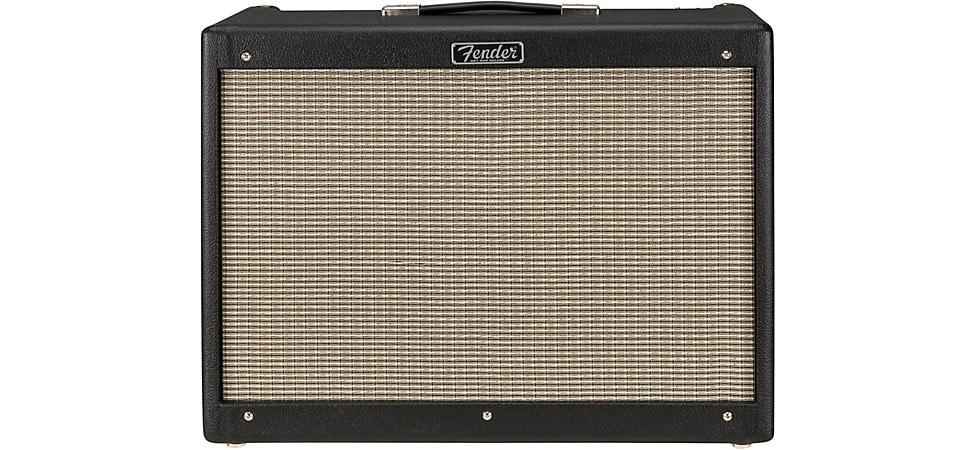
Shop Now: Fender Hot Rod Deluxe IV
The Hot Rod Deluxe IV is the classic Fender Deluxe model but with more flexibility and way more power. Still equipped with one 12" speaker like previous Deluxe amps (although here it’s a Celestion A-Type), the Hot Rod edition comes loaded with a blistering 40 watts for pristine cleans and warm overdrive. Along with three 12AX7 preamp tubes, two 6L6 power tubes and a solid-state rectifier, it also contains the same hot-rodded enhancements as other amps in the line—modified preamp circuitry, upgraded spring reverb and updated aesthetics. This is an excellent solution for those interested in the size and performance of a Fender Deluxe, but with the presence and attitude to fill bigger venues. Popular as a default backup amp, many venues have this reliable and consistent amp on hand. Also, if you’re interested in a Hot Rod Deluxe with a slightly bluesier tone, check out the Blues Deluxe reissue.
Fender Hot Rod Deville 212 IV
Why It's Cool: Sixty watts of ripping power through dual 12" speakers—built for outdoor venues and larger stages.
Things to Consider:
- Massive clean headroom at any volume
- 2x12" configuration cuts through any mix
- Great value with pro features at an accessible price
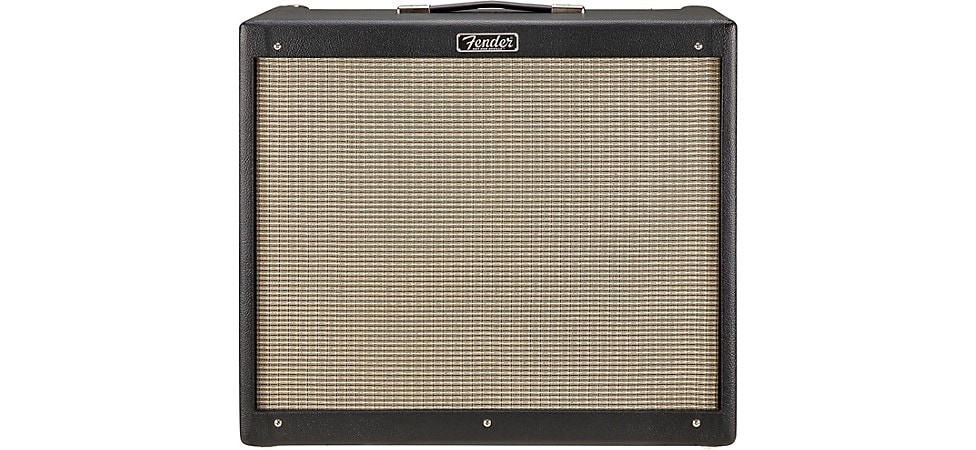
Shop Now: Fender Hot Rod Deville IV
The biggest and baddest amp in the Hot Rod lineup is the Deville 212 IV. While having the same tube complement as the Hot Rod Deluxe, the Deville 212 boosts power by increasing the tube voltages to yield a ripping 60 watts through a pair of 12" Celestion A-Type speakers. The increased wattage means increased headroom for a different sound quality than the Deluxe with later breakup. A great value for the gigging guitarist, the Hot Rod Deville provides the headroom, volume and tone needed to fill large spaces or even outdoor venues.
Fender Modeling and Solid-State Amps
Comparing Fender Modeling Amps
|
Model |
Wattage |
Speaker(s) |
Channels |
Onboard Effects |
Tonal Characteristics |
|
25W |
1x8" Fender Special Design |
Multiple |
24 Presets/20 Amp Models |
Beginner-focused modeling with simple interface |
|
|
50W |
1x12" Fender Special Design |
Multiple |
24 Presets/20 Amp Models |
Expanded power covers practice to performance |
|
|
50W |
1x12" Celestion |
Multiple |
200 Presets/Bluetooth |
Gig-ready modeling with footswitch |
|
|
100W |
1x12" Celestion |
Multiple |
200 Presets/Bluetooth |
Ultra-expressive modeling powerhouse |
Fender Mustang LT Series
Why They're Cool: Ideal for purposeful practice or tonal exploration.
Things to Consider:
- Presets offer wide tonal range with fine control via the faceplate
- Built-in tuner streamlines silent practice
- A flexible “little rig” for pickers who want more from their flow
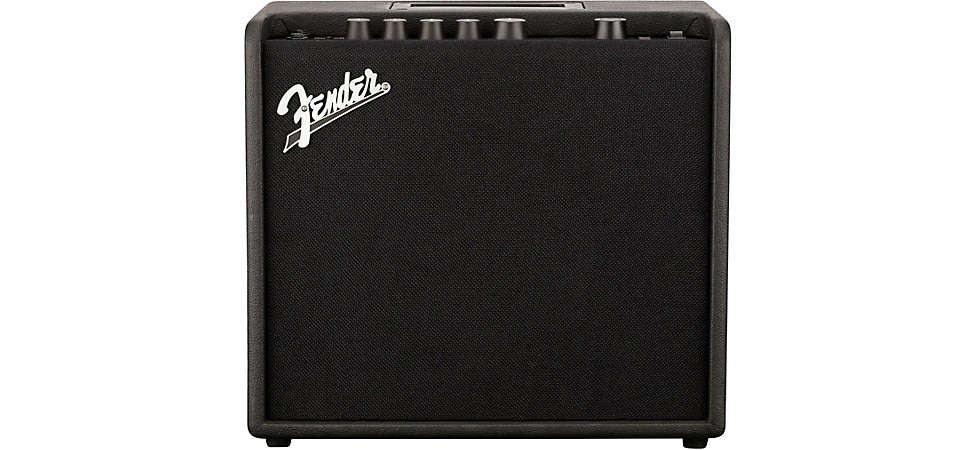
Shop Now: Fender Mustang LT25
The Fender Mustang LT Series is made up of two do-it-all amplifiers that are ideal for beginners or student guitarists who plan to move into actual performances with the same amp. Modestly priced, both the 25-watt Mustang LT25 and the 50-watt Mustang LT50 provide you with an incredibly simple yet expansive control set, 24 preset guitar tones and an amazing collection of 20 amp models, from vintage classics to modern high-gain distortion. The Mustang Series of amps also contains 12 onboard effects, including chorus, flanger and tremolo. Even more can be accessed with a computer hookup. Both amplifiers in the Mustang LT Series contain a 12" Fender Special Design speaker inside a lightweight wooden cabinet.
Fender Mustang GTX Series
Why They're Cool: This powerhouse modeling combo is great for gigging, home or studio use.
Things to Consider:
- Both 50W and 100W give plenty of stage-level volume without sacrificing tonal nuance
- Digital flexibility means instantly switching genres, amp profiles and FX
- Wi‑Fi and footswitch capabilities level it up for live control
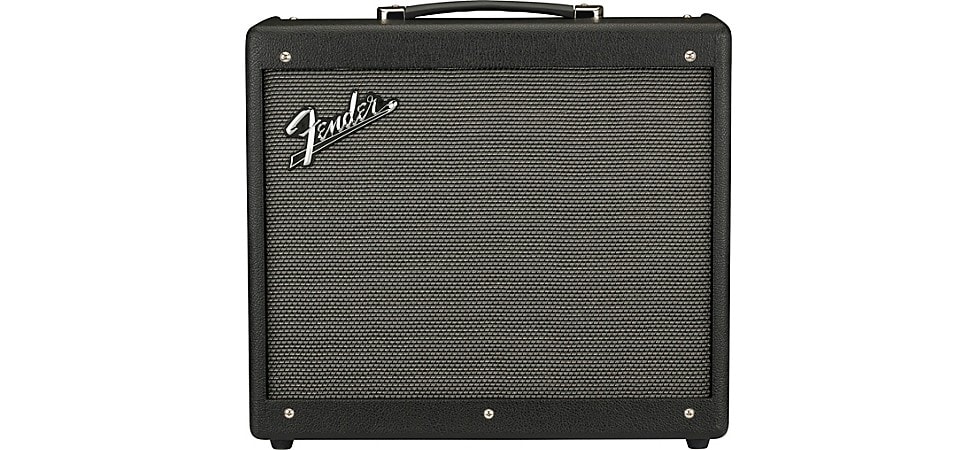
Shop Now: Fender Mustang GTX50
Looking to go even bigger and bolder? The Mustang GTX amps offer the versatility and convenient portability of the Mustangs LT series amps but these are packed with even more features, styles and tones to choose from. Along with a comprehensive collection of amp models and effects, the Mustang GTX amps also provide 200 onboard presets, so you’ll never have to waste time hunting down the perfect tone again. These gig-ready cabs each contain a single 12" Celestion speaker and Bluetooth capability for playing along with streaming tracks or remotely accessing Fender TONE 3.0 for deep-dive editing, preset backup and more. Available in the 50-watt Mustang GTX50 and the ultra-expressive Mustang GTX100 with 100 watts of sound shaping power (and an included footswitch), these Fender amps are the pinnacle of flexibility and value.
For the Finicky Fender Fan: Champion II Series
The Fender Champion series has long been a favorite among guitarists for its versatility and ease of use. The Champion II line takes these strengths and builds on them, delivering even more flexibility and power for players who need a little extra headroom.
Comparing Fender Solid-State Amps
|
Model |
Wattage |
Speaker(s) |
Channels |
Onboard Effects |
Tonal Characteristics |
|
25W |
1x8" Fender Special Design |
1 |
Built-in Effects |
Perfect for beginners and small gigs |
|
|
50W |
1x12" Jensen |
2 |
Effects Selection/TAP Button |
Flexible two-channel for rehearsals |
|
|
100W |
2x12" Jensen |
2 |
Effects Selection/TAP Button |
Force for larger performances |
|
|
10W |
1x6" Fender Special Design |
1 |
Overdrive Switch |
Entry-level practice amp with iconic styling |
Fender Champion II 25
Why It's Cool: It's a perfect beginner amp that handles both practice sessions and small gigs with ease.
Things to Consider:
- Clean and overdrive tones to cover jazz, country, blues and rock playing styles
- Built-in effects selection adds expression layer without requiring external pedals
- Compact enough for home use, powerful enough for rehearsals

Shop Now: Fender Champion II 25
A great starting point for beginners, the Champion II 25 is a single-channel combo amp that packs a punch despite its compact size. Its clean and overdrive tones are perfect for jazz, country, blues and rock playing, and the built-in effects selection adds an extra layer of expression. Whether you're rehearsing at home or performing small gigs, this amp delivers reliable sound.
Fender Champion II 50
Why It's Cool: This flexible two-channel combo rocks small stages and band rehearsals.
Things to Consider:
- 50 watts with 12" Jensen speaker provides reliable power for live performance
- TAP tempo button allows precise synchronization of effects
- Familiar amp-style controls keep it simple

Shop Now: Fender Champion II 50
The Champion II 50 is a flexible, two-channel combo amp designed for small stages and rehearsals. With its single 12" Jensen speaker and 50 watts of powerful sound, it's ideal for musicians who need versatility and a little more oomph in their setup. The built-in effects selection and TAP button allow you to craft and sync your sound with precision.
Fender Champion II 100
Why It's Cool: The amp you need for larger performances and bigger bands.
Things to Consider:
- 100 watts provides authority for large venue performances
- 2x12" Jensen configuration helps you cut through any mix
- Built-in effects selection and TAP button give flexibility for compelling tone creation

Shop Now: Fender Champion II 100
For larger performances and bigger bands, the Champion II 100 is a force to be reckoned with. This dual-channel combo amp boasts two custom 12" Jensen speakers and packs 100 watts of clean, overdrive, British and modern distortion tones into an easily transportable package. The effects selection and TAP button give you the flexibility to create a compelling tone and match the effects to any song tempo.
Fender Frontman 10G
Why It's Cool: Fender's most affordable full-size amp gives you iconic styling at an unbeatable price.
Things to Consider:
- Perfect starting point for Guitar Center Lessons students and beginners
- Gain control and overdrive switch cover clean to growly fuzz territory
- Available bundled with Squier Stratocaster for complete starter package
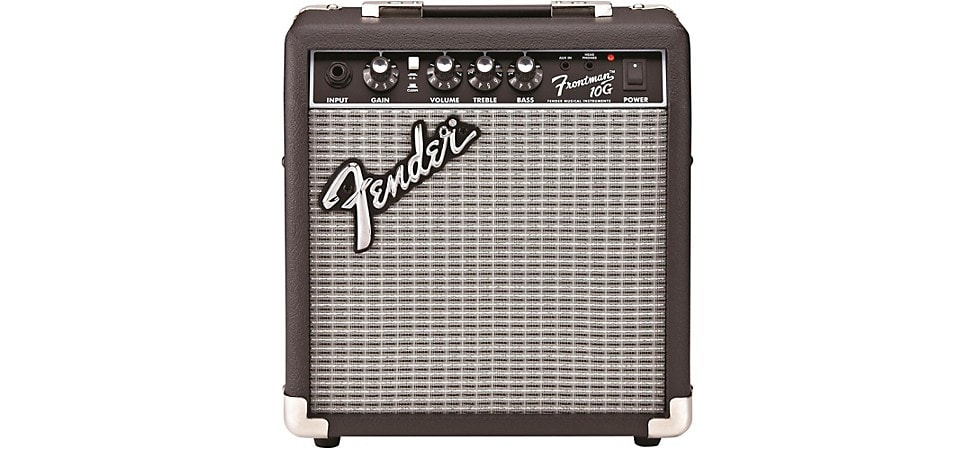
Shop Now: Fender Frontman 10G
While the Champion Series is an excellent starting place for any burgeoning electric guitarist, the Fender Frontman 10G also deserves a mention. As Fender’s most affordable full-size amp, this handy little practice unit offers a modest 10 watts with one 6" Fender Special Design speaker. You get a gain control and overdrive switch for dialing in both Fender cleans and growly fuzz, a single input and iconic Fender style, all in one unit. Also available in a bundle with a Squier Stratocaster, the Frontman 10G amp is a perfect pick for Guitar Center Lessons students.
Fender Tone Master Series: Modeled Tube Tone
The Fender Tone Master line of amps is designed to provide accurate recreations of classic Fender tube amps infused with the versatility of modern technology. Each of the Tone Master amps are made to faithfully emulate one classic Fender model with the exact same output, circuitry and tone of those iconic originals. Not only do they give you a tonally accurate vintage experience, but they’re also more affordable and require less maintenance than actual vintage tube amps. Not to mention, they’re about half the weight of the standard reissues.
Comparing Fender Tone Master Amplifiers
|
Model |
Wattage |
Speaker(s) |
Channels |
Onboard Effects |
Tonal Characteristics |
|
100W (22W tube equiv.) |
1x12" |
2 |
Modeled Tube Reverb/Tremolo |
Digital recreation of '65 Deluxe with modern features |
|
|
45W |
4x10" Jensen |
2 |
Modeled Tube Reverb/Tremolo |
Half the weight; same classic tone |
|
|
200W (85W tube equiv.) |
2x12" |
2 |
Modeled Tube Reverb/Tremolo |
Affordable access to Twin Reverb tone |
|
|
50W (12W tube equiv.) |
1x10" Jensen |
1 |
3-Band EQ/Onboard Effects |
Classic Princeton with modern convenience |
|
|
45W |
4x10" Jensen |
2 |
Effects Loop |
Legendary Bassman tone in modern package |
Fender Tone Master Deluxe Reverb
Why It's Cool: Get genuine tube-like tone modeled on the '65 Deluxe Reverb with half the weight and modern convenience.
Things to Consider:
- 50-watt amp recreates the response of a 22-watt tube amp
- Modern updates, including XLR line output, mute switch and USB port for firmware upgrades
- All the vintage tone without tubes to replace or bias adjustments
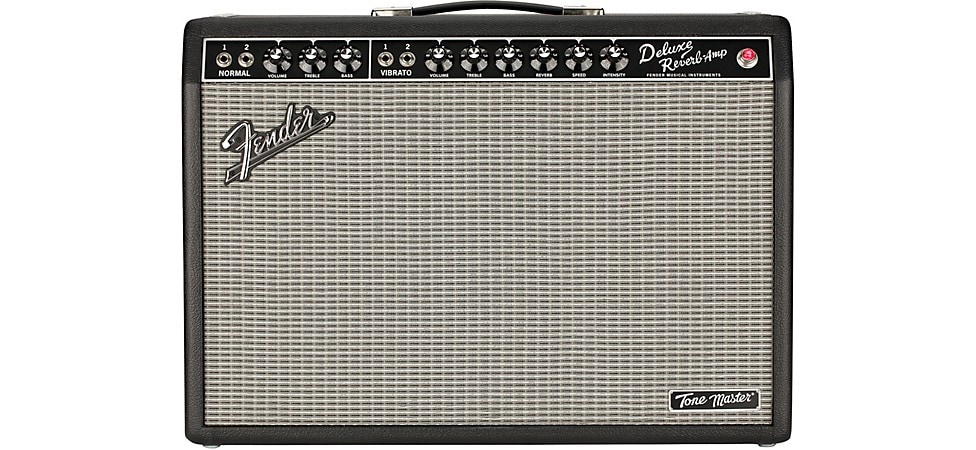
Shop Now: Fender Tone Master Deluxe Reverb
This solid-state version of the ’65 Fender Deluxe Reverb delivers genuine tube-like tone modeled on the same circuitry and 22-watt output of the classic black panel amplifier. Being a digital version, the Tone Master Deluxe Reverb does come with some modern convenience features like an XLR line output, a mute switch and a USB port for firmware upgrades. However, the warm tube tone and the front panel controls are pure recreations of the ’65 Deluxe Reverb.
Fender Tone Master Super Reverb
Why It's Cool: Discover classic '65 Super Reverb tone in a package half the weight of the original.
Things to Consider:
- Four 10" Jensen speakers and exact front-panel recreation of original for vintage accuracy
- Consistent performance without tube aging or maintenance issues
- Modern features, such as USB and XLR outputs on back panel, maintain vintage front interface
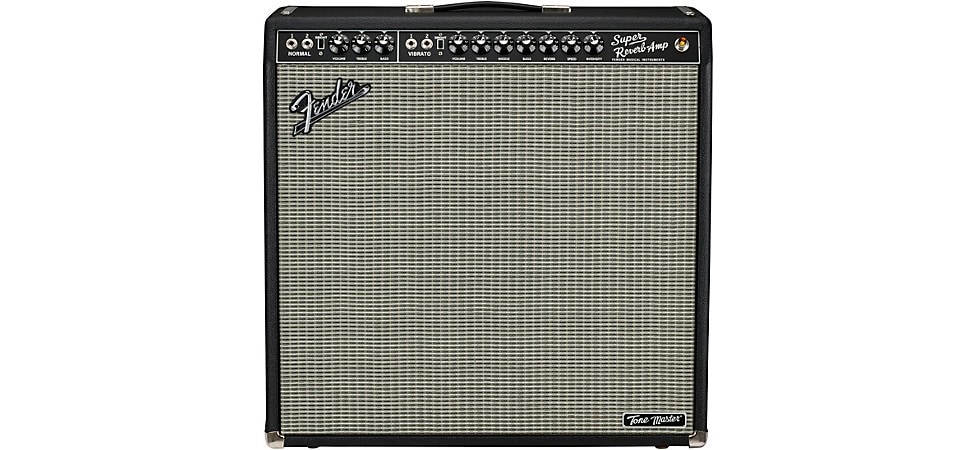
Shop Now: Fender Tone Master Super Reverb
The Tone Master Super Reverb recreates the 45-watt output and classic tube tone of the ’65 Super Reverb. The front control panel mimics the original version, but the back panel contains a few of the modern features offered by today’s digital amps. Based on the original ’60s black panel circuit and containing four 10" Jensen speakers, your ears—and your audience—won’t be able to tell the difference. Plus, this solid-state amp is half the weight of the original and requires far less maintenance.
Fender Tone Master Twin Reverb
Why It's Cool: Get legendary '65 Twin Reverb performance at a more manageable price and weight.
Things to Consider:
- 200-watt power amp maintains same dynamic range and tone as the 85-watt tube original
- Half the weight makes this viable for musicians who struggled with tube Twin weight
- Genuine vintage tone without the premium price of tube construction
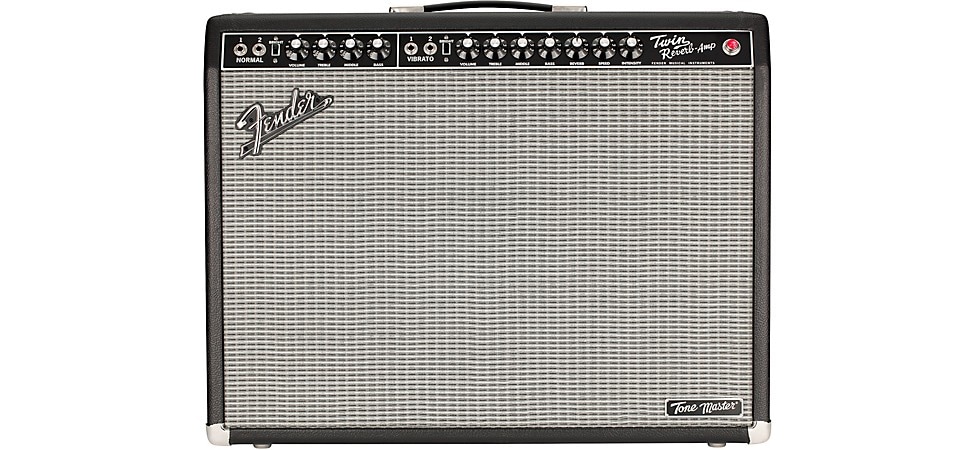
Shop Now: Fender Tone Master Twin Reverb
The Fender Tone Master Twin Reverb solid-state amplifier brings the tone and performance of the original ’65 Twin Reverb tube amp down to a more manageable price. Again, the front panel controls and tonal output are meticulously crafted to replicate the ’65 black panel models exactly, but this digital version also gives you updated features that the originals and reissues don’t. At half the weight of an original all-tube Fender Twin with the same dynamic range and tone, this affordable, low-maintenance Tone Master is a no-brainer for the modern guitarist seeking genuine vintage tone.
Fender Tone Master '59 Bassman
Why It's Cool: Capture the iconic tone of the legendary guitar amp that inspired the Marshall stack.
Things to Consider:
- Rich, full tone that made the original a favorite among roots and blues players
- Four custom Jensen 10" speakers with effects loop for seamless pedal integration
- Perfect for players demanding both Tweed heritage and contemporary features

Shop Now: Fender Tone Master '59 Bassman
The Tone Master '59 Bassman takes Fender's modeling mastery and creates an amp that captures the iconic tone of one of their most legendary guitar amps. With its rich, full sound and versatility in delivering across a wide range of playing styles, this 4x10" combo is perfect for players who demand the best from their gear. Featuring four custom-designed Jensen 10" speakers and an effects loop for seamless integration with external pedals, the Tone Master '59 Bassman offers a modern take on a classic design. Despite the name, this amp—given its versatility and rich tone—is a favorite among roots, Americana and blues guitarists. Whether you're looking to tap into Fender's heritage or simply want a high-quality amp for your next gig, the Tone Master '59 Bassman delivers.
Fender Tone Master Princeton Reverb
Why It's Cool: Get the essence of one of Fender's most iconic ’60s amps with added precision and control.
Things to Consider:
- 10" custom Jensen speaker summons the warm, rich tone that made the original legendary
- 3-band EQ provides precise tonal shaping beyond original specifications
- Range of onboard effects extends versatility for contemporary players

Shop Now: Fender Tone Master Princeton Reverb
The Tone Master Princeton Reverb distills the essence of one of Fender's most iconic guitar amps from the '60s. With its custom-designed 10" Jensen speaker, this combo delivers the warm, rich tone that made the original Princeton a legend among players. Featuring 3-band EQ for precise tonal shaping and loaded with a range of onboard effects, the Tone Master Princeton Reverb is the perfect tool for musicians who demand great sound from their gear. This amp is ideal for gigging musicians, home recordists or anyone looking to upgrade their tone with a little bit of Fender magic. Whether you're a seasoned pro or just starting out, the Tone Master Princeton Reverb will help you achieve your tone goals with ease.
Fender Acoustic Guitar Amps: Maximize Acoustic-Electric Tone
Players specializing in acoustic-electric guitars may be more interested in something from Fender’s extensive line of acoustic amps. Made specifically to bring out warm, balanced and natural acoustic tone, these amps unlock the full range of your acoustic-electric guitar. You can also easily add vocals into the mix with microphone-capable channels found on all Fender acoustic amplifiers. Aside from adding controls and features for acoustic guitar players, an acoustic amp makes it easy to dial in recognizable acoustic tones, from classic acoustic folk rock to more traditional Americana and country styles.
Comparing Fender Acoustic Guitar Amplifiers
|
Model |
Wattage |
Speaker(s) |
Channels |
Onboard Effects |
Tonal Characteristics |
|
15W |
1x6" |
1 |
Chorus |
Compact acoustic amplification with sweetening EQ |
|
|
40W |
2x6.5" |
2 |
Reverb |
Dual speakers for larger venues and gatherings |
|
|
100W |
1x8" |
2 |
Menu of Effects/Bluetooth |
High-powered, versatile acoustic amplifier |
|
|
100W |
1x8" |
2 |
Effects Selection/Looper/Bluetooth |
Modern acoustic amp with expanded features |
|
|
100W |
1x8" |
2 |
Effects/Looper/Bluetooth |
Battery-powered for ultimate portability |
|
|
100W |
1x8" + Tweeter + 6.5" Side |
2 |
SFX Circuitry Effects |
Three-dimensional sound with side-radiating speaker |
Fender Acoustasonic Amps
Why They're Cool: Project the nuance of your acoustic tone to larger audiences.
Things to Consider:
- 15W and 40W watts are perfect for small to medium sized venues
- Built-in chrous (15W model) and reverb (40W model) help bring out acoustic guitar's resonant qualities
- Both guitar and microphone inputs with independent level controls for added versatility
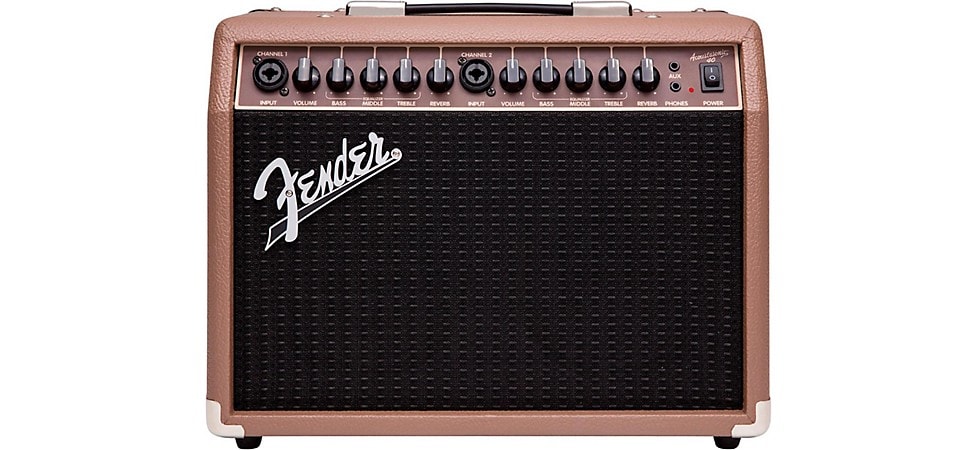
Shop Now: Fender Acoustasonic 40
The Acoustasonic amps are built to get the most out of your acoustic-electric guitar with additional features geared towards acoustic players. With the Acoustasonic’s EQ controls, you can easily sweeten the tone to suit your specific instrument or to account for the performance space. Fender Acoustasonic amps are available in either a 15-watt unit with onboard chorus or a 40-watt version with built-in reverb. Depending on your needs, these can handle everything from rehearsals and private performances to larger events and gatherings. Both Acoustasonic amplifiers contain one 6" speaker and XLR mic inputs.
Fender Acoustic 100
Why It's Cool: This premium 100-watt acoustic amplifier gets your guitar and your voice across in style.
Things to Consider:
- 100 watts ensures acoustic tone projects throughout small and large stages
- Bluetooth to stream backing tracks or use for solo practice and performance
- Dual Channel Flexibility with inputs that work with both instruments or microphones
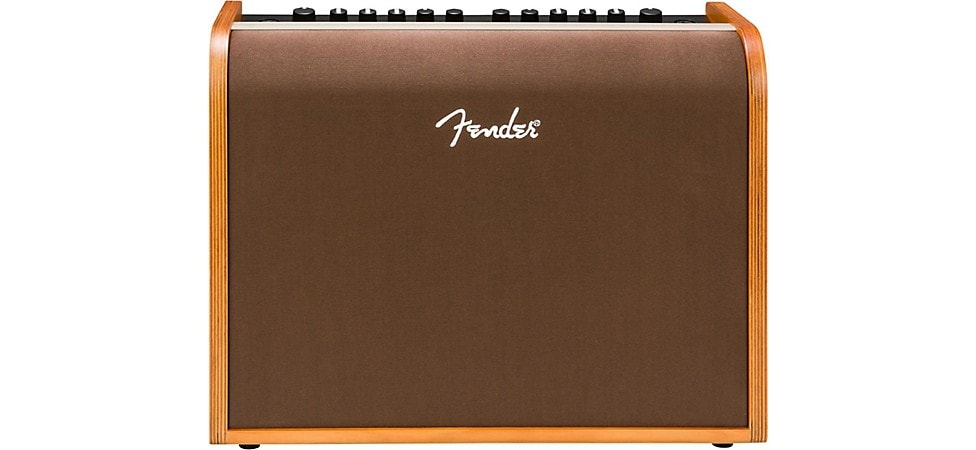
Shop Now: Fender Acoustic 100
Simple, sleek and stylish, the premium Fender Acoustic 100 is a high-powered and versatile acoustic amplifier ideal for the solo gigging guitarist. 100 watts and one 8" speaker ensure that your acoustic tone is fully projected throughout small and large stages alike, with every nuance of your playing articulated. A cleverly integrated carry handle is also of note on this acoustic amp, along with a beautifully varnished plywood shell and brown speaker cloth that nicely complement the aesthetic of acoustic guitar. The Acoustic 100 amp features two channels, each with access to the same menu of tasteful onboard effects for virtually endless combination options and Bluetooth capability. Both inputs can be used with either an instrument or a microphone, making this amp just as suitable for two vocalists as it is for an acoustic duo.
Fender Acoustic Junior
Why It's Cool: Get advanced features in acoustic amplification that won't break the bank.
Things to Consider:
- Looper function provides effortless control over solo performance layering
- Just 15 pounds makes this easy to transport anywhere
- Traditional looks with technical sophistication
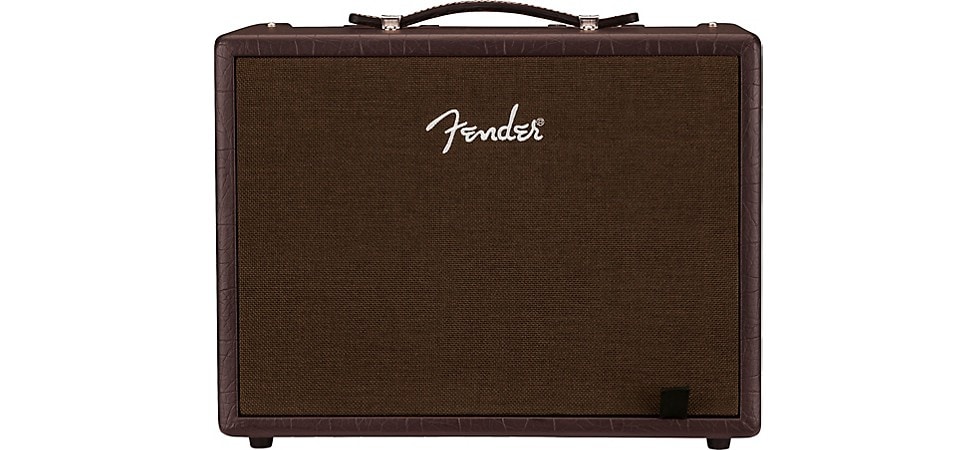
Shop Now: Fender Acoustic Junior
If you’re in the market for a modern acoustic amp with a different visual aesthetic, check out the Acoustic Junior. Similar to the Acoustic 100 in performance and output with 100 watts, two channels and one 8" speaker, the Fender Acoustic Junior boasts an expanded feature set and a textured vinyl covering that’s a bit more traditional. Along with Bluetooth capability for audio streaming or jamming with backup tracks, the Acoustic Junior also includes a Looper function for effortless control over the ample effects options. Plus, weighing in at just 15 lb., this versatile acoustic amp is easy to take anywhere.
Fender Acoustic Junior GO
Why It's Cool: Get the ultimate portable, rechargeable acoustic amp and get rockin' in any location.
Things to Consider:
- Rechargeable battery provides 5 hours at full volume and 12 hours at moderate volume
- Perfect for street performances, camping or anywhere AC power isn't available
- Same high-quality effects and sound as AC-powered Acoustic Junior
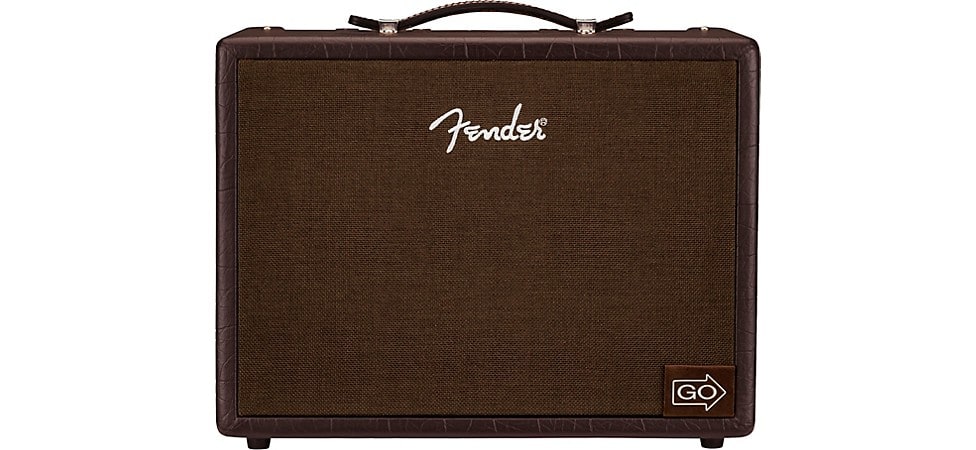
Shop Now: Fender Acoustic Junior GO
The great thing about acoustic guitar is that it can be done in virtually any location. Now there’s an amplifier that is just as versatile. The Acoustic Junior GO has the build, look and studio-quality effects of the Acoustic Junior, but it also includes a rechargeable lithium-ion battery that provides 5 hours of playing time at full volume, or 12 hours at moderate volume. For traveling guitarists or performance artists, the Acoustic GO makes it easy to set up a pop-up show or outdoor jam session.
Fender Acoustic SFX II
Why It's Cool: Experience three-dimensional acoustic sound for rich, immersive tone.
Things to Consider:
- Multi-speaker design with an 8" main speaker, tweeter and 6.5" side speaker creates spacious sound
- Enhanced effects processing adds texture and character beyond standard acoustic amps
- 22-pound weight and compact size balances portability with substantial sound projection
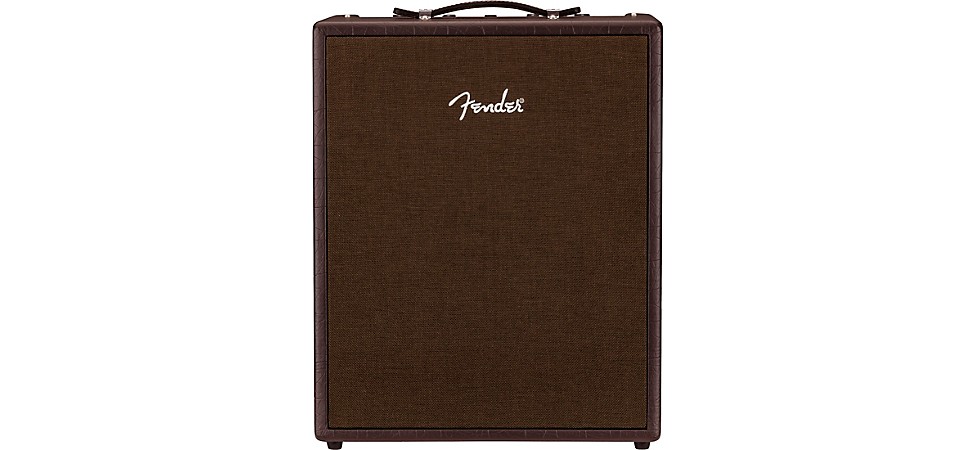
Shop Now: Fender Acoustic SFX II
The Fender Acoustic SFX II amp offers the same stylish yet discrete look of the Acoustic Junior but with enhanced effects and more punch to fill larger spaces. Along with a main 8" low-frequency speaker and tweeter, the Fender Acoustic SFX II also includes a 6.5" side-radiating speaker for rich, three-dimensional sound. Despite massive volume and power, this stylish acoustic amp weighs in at just 22 lb. for hassle-free transport between gigs. The Acoustic SFX II amplifier also has the same layout of effects available on both channels. However, the SFX II utilizes SFX circuitry in conjunction with the side-firing speaker to add even more texture and character to your sound.
Fender Mini Amps: Pocket-Sized Projection
Sometimes the only person you’re playing for is yourself. When you just want to relax and jam but still crave clean Fender tone or a little distortion, Fender Mini Amps are a fantastic selection. Each mini amp is inspired by a specific classic Fender amp model, but in a super compact, low-wattage version that easily fits in your gig bag for convenient transportation. They’re the perfect size for dorm rooms or the office, and they also make great, affordable gifts for the guitarists in your life. It is worth noting that while distortion is built in, the cleans are where these mini amps really shine.
Comparing Fender Mini Amplifiers
|
Model |
Wattage |
Speaker(s) |
Channels |
Onboard Effects |
Tonal Characteristics |
|
1W |
2x2" |
1 |
Built-in Distortion |
Portable tweed-era tone with vintage appeal |
|
|
1W |
2x3" |
1 |
Built-in Distortion |
Black panel-era styling with tilt-back stand |
|
|
1W |
2x2" |
1 |
Built-in Distortion |
Classic Deluxe amp aesthetic in mini format |
|
|
1W |
2x2" |
1 |
Built-in Distortion |
Vintage Tone Master styling with period details |
|
|
N/A |
Headphone Output |
Multiple |
25 Amp & Effects Models/Bluetooth |
Compact headphone amplifier and interface |
|
|
N/A |
Headphone/USB Output |
Multiple |
Mustang Series Tones/Bluetooth |
Enhanced personal amplifier with recording capability |
Fender Mini ’57 Twin
Why It's Cool: Get the legendary '57 Twin, complete with authentic tweed covering, shrunk down to fit in your gig bag.
Things to Consider:
- Runs on a single 9V battery for true portability and desk-friendly jamming
- Perfect conversation piece that actually sounds good and fits in your gig bag
- Volume, Tone and Gain controls provide surprising range from mini format
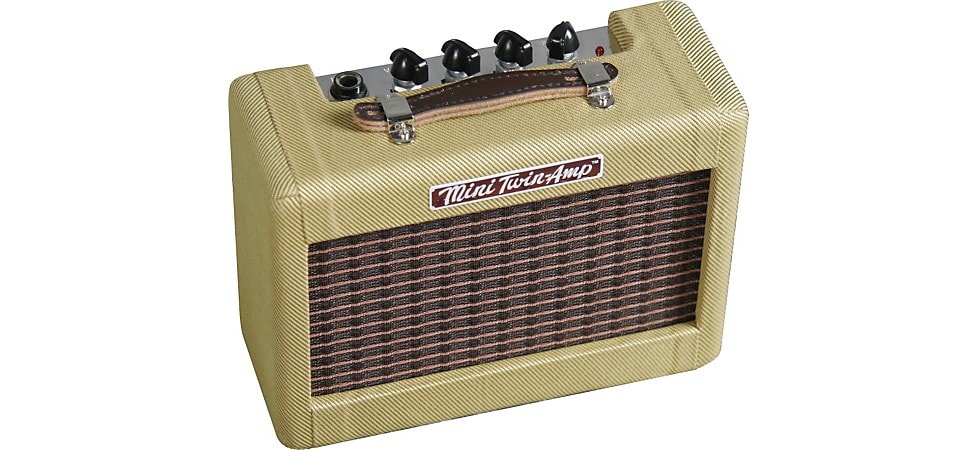
Shop Now: Fender '57 Mini Twin
This handy unit is a portable headphone amp modeled after the classic full-size tweed era Fender ’57 Twin. With one watt of power, this mini Fender amp contains two 2" speakers and a ’50s-style tweed covering for added vintage appeal. The Mini ’57 Twin amplifier includes built-in distortion and features Volume, Tone and Gain controls to fine-tune your tone from clean to mean. Best of all, this little tweed trooper can be powered by one 9V battery (sold separately). It works great simply as a display item, but it also serves as a compact, functional amp for anytime the mood to play strikes.
Fender Mini ’65 Twin
Why It's Cool: This Black Panel-era classic rocks with a tilt-back kickstand just like its big sibling.
Things to Consider:
- 2x3" speakers provide more punch than typical mini amp configuration
- 9V battery included (a pleasant change) for immediate plug-and-play operation
- Tilt-back design captures full-size Twin Reverb vibe
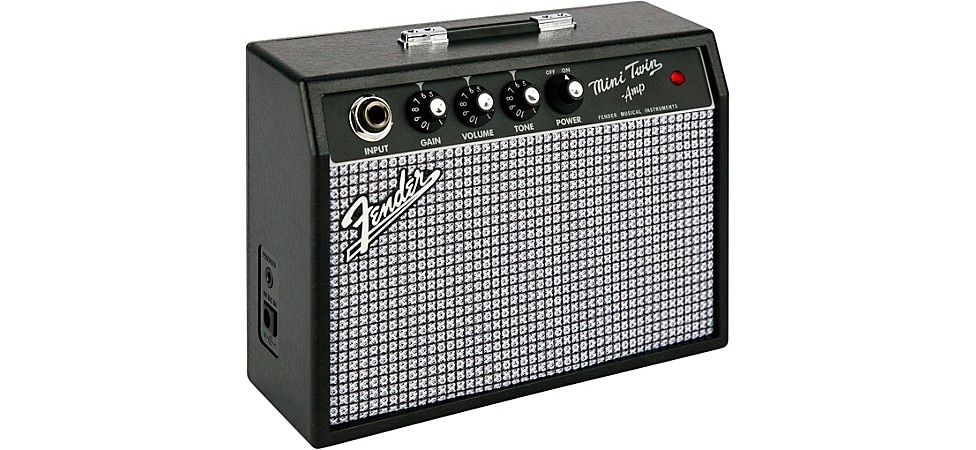
Shop Now: Fender Mini '65 Twin
If the black panel era is more your style, the Fender Mini ’65 Twin is a portable replication of that classic full-size amplifier. Like the Mini ’57, the Mini ’65 Twin delivers one watt of power with Volume, Tone and Gain controls. However, the ’65 comes with two 3" speakers for a touch more punch, a tilt-back kickstand just like the full-size version and a 9V battery (included) for convenient on-the-go operation.
Fender Mini MD20 Deluxe
Why It's Cool: Get the rich, clean tone and classic look of a full-size Deluxe in palm-sized format.
Things to Consider:
- Classic styling that recreates the visual appeal of vintage Deluxe amplifiers
- 2x2" speaker configuration provides balanced mini amp projection
- Ideal size and price for you or the guitar players in your life
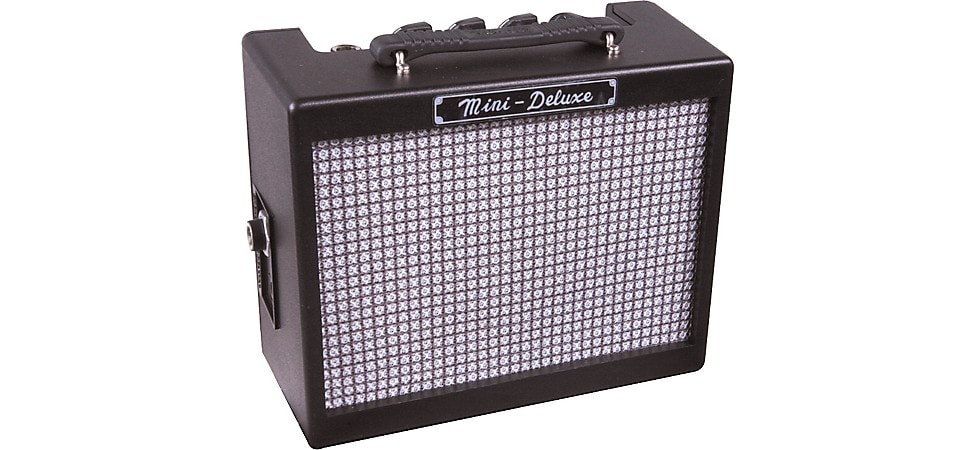
Shop Now: Fender MD20 Mini Deluxe
The Fender MD20 Mini Deluxe recreates the rich, clean tone and classic look of a full-size Deluxe amp. Similar in build to the Mini ’57 Twin, the single-channel MD20 Deluxe amp contains two 2" speakers with 1 watt of power that’s just enough for practice, rehearsal or even a small get-together.
Fender Mini Tone-Master
Why It's Cool: This one-watt tone machine puts Tone Master power in your pocket.
Things to Consider:
- Brown grille cloth and white knobs provide authentic period appearance
- Full-size, 1/4" headphone jack allows for silent practice anywhere
- Included 9V battery makes this perfect for street performance
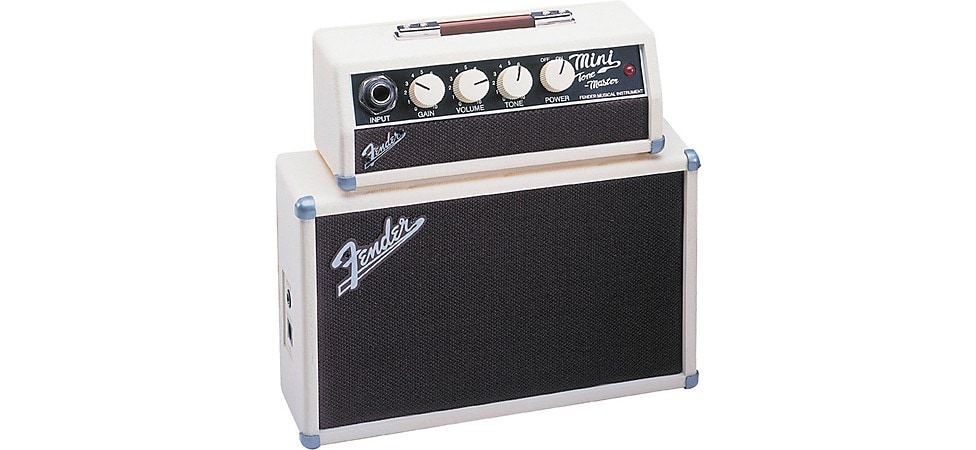
Shop Now: Fender Mini Tone-Master
The one-watt, one-channel Mini Tone-Master amplifier is based on the original Tone-Master. Great as a personal amp or a gift, this little tone machine has a classic look with period-accurate metal amp corners, a brown vintage-style grille cloth and white knobs. Inside are two 2" speakers and a 1/4" headphone jack for silent play. A great option for busking, the Mini Tone-Master offers portable power with an included 9V battery.
Fender Mustang Micro Headphone Amplifier
Why It's Cool: This pocket-sized powerhouse is loaded with tone.
Things to Consider:
- Clips directly to guitar headstock for anywhere practice
- 25 Tone Master amp and effects models provide vast tonal possibilities
- Bluetooth integration to play along with streaming audio for practice and jamming
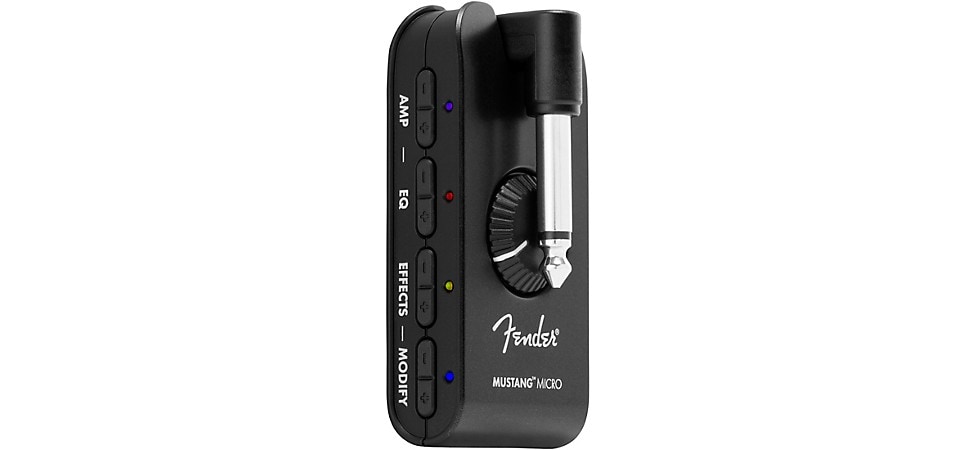
Shop Now: Fender Mustang Micro Headphone Amplifier
If you’re looking to jam on the go or want to explore the extensive tonal offerings of the Mustang Series on your own, check out the Fender Mustang Micro. A compact and powerful guitar headphone amplifier and recording interface, you can saddle up the Mustang Micro at any time and take it anywhere—just grab your headphones and plug in your guitar. It's great for late-night jams, study breaks, camping trips or anywhere you’re inspired to play. The small but mighty Mustang Micro is loaded with 25 amp and effects models, plus Bluetooth capability for playing along to streaming audio. The Mustang amp packs a whole lotta fun into one pocket-sized device.
Fender Mustang Micro Plus Headphone Amplifier
Why It's Cool: Up your mini-amp game with this enhanced touch-controlled personal amplifier.
Things to Consider:
- USB-C recording interface captures both guitar tone and streaming audio simultaneously
- Responsive touch control interface provides easy access to all functions
- 1/8" stereo headphone output delivers full-range sound for practice or performance

Shop Now: Fender Mustang Micro Plus Headphone Amplifier
The Mustang Micro Plus is a compact personal guitar amplifier perfect for practice or playing on the go. It features a wide selection of tones from the popular Mustang series amps, along with built-in effects and a responsive touch panel. This digital amp lets you jam along with your favorite tunes via Bluetooth audio streaming, and practice silently using its 1/8" stereo headphone output. You can even record your guitar tone and the audio stream simultaneously using the USB-C output. Whether rehearsing at home or performing small gigs, the Mustang Micro Plus is a reliable companion for musicians of all levels.
Vintage Fender Amps: Ain't Nothin' Like The Real Thing
Looking to score an original Fender amp? Be sure to check out the constantly changing inventory of vintage Fender amplifiers including tweed, brown panel, black panel and silver panel models. You never know what classic Fender amp might be looking for a new home.
Again, the legacy of Fender amps can’t be understated. You can practically trace the evolution of music through the history of Fender amplifiers. Fender has helped to preserve this history with authentic reissues from each of their vintage eras, while also staying on the cutting edge of amplifier engineering with constant innovations and improvements.
We hope this guide has helped you find the perfect amp for you and your guitar, whether it’s a starter electric or a trusty gigging acoustic. No matter what your needs are, there’s a Fender amp made to meet them. From a first practice amp to a reliable gigging combo or a fresh lightweight unit with the latest in modeling tech, we’ve got your next—or your first—favorite Fender amp right here.
.jpeg)






